#the map of the nine realms art
Text

The Map of the Nine Realms
By: kade32 [DeviantArt]
Source
Originally posted:2018/12/12
Yggdrasil, commonly known as the "World Tree" which contains and holds the Nine Realms together.
THE NINE REALMS:
Ásgarðr (Asgard), the homeworld of the Æsir gods and Ásynja goddesses and the Bifrost.
Valhöll (Valhalla), Odin's realm in Asgard and the heavenly home of the valkyries who decide which warriors die in battle and who lives.
Valaskjalf, Odin's palace.
Þrúðheimr (Thrudheim), the residence of Thor.
Breiðablik, the residence of Baldr.
Himinbjörg, the dwelling of Heimdallr.
Álfheimr (Alfheim), a beautiful, prosperous and bright realm free of the iron grip of war and famine and the homeworld of the álfar/ljósálfar (light elves).
Miðgarðr (Midgard), also known as Earth, the homeworld of the mortals.
Vanaheimr (Vanaheim), a peaceful realm of great nature and the homeworld of the Vanir, lesser gods opposite to the Æsir.
Jötunheimr (Jotenheim or Udgård), the frozen, snowy and mountainous realm of endless winters and the homeworld of the jötnar (frost giants).
Múspellsheimr (Muspelheim), a fiery, molten realm of fire and heat, the homeworld of the "sons of Muspel" (fire giants) and their ruler, Surtr.
Svartálfaheimr (Svartalfheim), a darkened realm parallel to that of Nidavellir and the homeworld of both the svartálfar (black elves) and the dökkálfar (dark elves). Niðavellir (Nidavellir), a section of Svartalfheim inhabited by of the dvergar (dwarves), blacksmiths and craftsmen of the Æsir gods.
Niflheimr (Niflheim), a cold and lifeless netherworld enshrouded in a misty cloud of fog where the souls of the dishonorable arrive upon death.
Helheimr (Hel), the dark, labyrinthine realm of Hel where the evil souls become trapped for eternity and the homeworld by Hel, daughter of Loki.
[Text was copied from original post.]
#kade32#kade32 DeviantArt#the map of the nine realms#the map of the nine realms art#yggdrasil#yggdrasil art#yggdrasil world tree#yggdrasil world tree art#world tree#norse#norse god#norse gods#norse mythology#norse mythology art#norse mythology designs#norse shaman#norse myths#norse myths art#norse pagan#norse paganism
179 notes
·
View notes
Text
A short study on the origins of Gale Dekarios
Going through some game information and Forgotten Realms lore, I found some interesting tidbits about the possible origins of Gale and the Dekarios clan.
So, what do we know?



After finding Tara in Act 3, there's a dialogue tree (as of yet still bugged 08/12/2023) where Gale tells us that his surname comes from his mother, Morena Dekarios.
Gale: (...) Courtesy of my mother, the inimitable, dare I say it, sometimes unavoidable, Morena Dekarios.
There isn't much to go on from this. Other than a brief mention that Gale's parents denied him a kitten, we don't know where his father is or what happened to him. Indeed, the surname Dekarios could be inherited from Gale's mother or even his father's side — and for the latter we can assume Morena took on the surname sometime after marrying Gale's father, thus becoming her son's main reference for the rest of the clan upon her husband's absence/death.
That being said, I can't find anything about the Dekarios surname within DnD lore. What we do know, is that Gale's clan is scattered far and wide, perhaps even beyond the Sword Coast.
We also know that Gale is of full human heritage, at least from his closest ancestry.
Now, let's dig in a little deeper.
There are several human ethnicities throughout Faerûn.
As of DnD 3.5, there are seven major ethnic groups widely recognised: the Calishites, Chondathans, Damarans, Iluskans, Mulan, Rashemis, and Tethyrians.
However, as of DnD 5E, the Player's Handbook adds that there are actually nine major ethnic groups in Faerûn, including the Shou from Kara-Tur and the Turami who are native to the southern shore of the Inner Sea. In 3.5E, these groups just receive a brief mention, while in 5E there's more of an attempt on expanding their lore.
Note: If you're interested in knowing more about the different ethnic groups in Faerûn, I would suggest reading the Forgotten Realms: Races of Faerûn (2003), the 3.5 Player's Guide to Faerûn, the 5E Player's Handbook and the Sword Coast Adventurer's Guide.


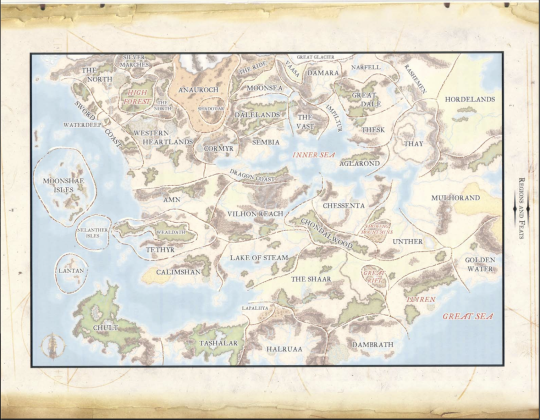
Here's a useful map of Faerûn from 3.5E.
It's actually the 3.5 Player's Guide to Faerûn and Forgotten Realms: Races of Faerûn that gives us more in depth information about which communities have a major presence in different areas of the Sword Coast.
For example, while Gale and his mother live in Waterdeep, we don't know whether they moved to the city when Gale was a child or, perhaps, his parents always lived there. Perhaps generations of Dekarios lived in Waterdeep — including Gale's aunt Agnes.
Without further information, it's possible that the Dekarios clan even has their ancestral roots beyond the Sword Coast. Who knows?

According to 3.5E, the recommended human subraces in The Sword Coast are the Illuskan and Tethyrian.
In Waterdeep, it's the Chondathan, the Illuskan and Tethyrian.

Given what we know of Gale, lorewise, what would be the most accurate ethnicity for the Dekarios clan? Let's see what the handbooks say about the three major groups in Waterdeep.
--
The Chondathan
Races of Faerûn (2003): (...) Although Chondathans make skilled mercenaries and cunning rogues, Chondathan culture, has not encouraged study of the Art or great religious fervor. Notable exceptions exist, particularly in the study of the Art among the Netherese influenced Chondathan cultures that lie north and west of the Inner Sea.
(...) Those Chondathans who dwell north and west of the Sea of Fallen Stars (except in Sembia) are more likely to have blue eyes and have fairer complexions and darker hair than those born in the South, evidence of a Netherese heritage. In Chondath itself, particularly in the lands bordering Sespech, a significant Shaaran influx in recent centuries has given many natives of Chondath more of an olive skinned hue.
(...) Chondathan Society (...) As Chondathans place a high value on book learning, many receive some amount of schooling while growing up.
(...) Animals and Pets (...) Chondathans favor small felines as pets and hunting companions (...). Tressyms are highly favored by those who can afford them, as are lynxes.
3.5E: Descended from the natives of the Vilhon Reach, these hardy folk have spread to settle most of the western and central Inner Sea region and much of the Western Heartlands. Chondathans form the primary racial stock of Altumbel, Córmyr, the southern Dalelands, the Dragon Coast, the Great Dale, Hlondeth and both shores of the Vilhon Reach, the Pirate Isles of the Inner Sea, Sembia, and Sespech. They are slender, tawny-skinned folk with brown hair that ranges from almost blond to almost black. Most are tall and have green or brown eyes, but these traits are hardly universal.
The Chondathan domination of central Faerún came about largely by virtue of extensive trade and settlement rather than by force of arms. Many Chondathans are merchants of one sort or another, and they are not afraid to take risks, travel, or settle new lands.
5E: Chondathans are slender, tawny-skinned folk with brown hair that ranges from almost blond to almost black. Most are tall and have green or brown eyes, but these traits are hardly universal. Humans of Chondathan descent dominate the central lands of Faerun. around the Inner Sea.
Chondathan Names: (Male) Darvin, Dorn, Evendur, Gorstag, Grim, Helm, Malark, Morn, Randal,
Stedd; (female) Arveene, Esvele, Jhessail, Kerri, Lureene, Miri, Rowan, Shandri, Tessele; (surnames) Amblecrown, Buckman, Dundragon, Evenwood, Greycastle, Tallstag
--
The Illuskans
Races of Faerûn (2003): (...) Wizards are rare in Illuskan society. They are widely feared and assumed to be in some way affiliated with the Arcane Brotherhood. Of those who do study wizardry, perhaps the most common specialization is the school of Evocation. Sorcerers and bards are more common among Illuskans, as many Illuskans have a trace of draconic ancestry in their heritage.
(...) Illuskans are not inclined to keep animals as pets, companions, or familiars, as relatively few species are native to Ruathym or
nearby islands. Goats, sheep, and geese do better in the cold Illuskan lands than do cattle, swine, or chickens.
3.5E: : The seagoing, warlike people of the Sword Coast, North, the Trackless Sea, and the Desarin river valley, Illuskans are tall, fair-skinned folk with blue or steely gray eyes. Among the
islands of the Trackless Sea and Icewind Dale, their hair color tends
toward blond, red, or light brown. On the mainland south of the
Spine of the World, however, raven-black hair is most common.
Iluskans are proud, particularly of their ability to survive in the harsh environment of their northern homelands, and they regard
most southerners as weak and decadent. Illuskans make their livings as farmers, fishers, miners, sailors, raiders, skalds, and runecasters.
5E: Illuskans are tall, fair-skinned folk with blue or steely gray eyes. Most have raven-black hair, but those who inhabit the extreme northwest have blond, red, or light brown hair.
Illuskan Names: (Male) Ander, Blath, Bran, Frath, Geth, Lander, Luth, Malcer, Stor, Taman, Urth; (female) Amafrey, Betha, Cefrey, Kethra, Mara, Olga, Silifrey, Westra; (surnames) Brightwood, Helder, Hornraven, Lackman, Stormwind, Windrivver
--
The Tethyrian
Races of Faerûn (2003): (...) In recent centuries, these disparate groups have gradually coalesced into a relatively new ethnic group known as Tethyrians, occupying a vast territory stretching from Calimshan to Silverymoon and from the Sea of Swords to the Sea of Fallen Stars. After centuries of enslavement and oppression by one group or another, Tethyrians are fiercely independent, protective of their freedoms and suspicious of threats posed by powerful kingdoms and empires. Given their disparate ancestry, Tethyrians have never developed a unique language of their own, instead adopting the language of the latest wave of conquerors or refugees. Today most Tethyrians speak Chondathan.
(...) Outside Calimshan, many Tethyrians are craftsmen or caravanners, while others find employment as mercenaries in the employ of other realms. Tethyrians make skilled fighters and rogues, reflecting the struggle to survive successive waves of conquest and generations of warfare. Tethyrian culture has a long tradition of bardcraft, reflecting the absence of a Tethyrian empire at any point ni history and the corresponding reliance on itinerant bards to preserve and spread Tethyrian oral history.
(...) Tethyrians view life as a struggle to be survived through ties to Family, clan, and tribe. To a Tethyrian, freedom is the most precious gift, and the enslavement of another is the greatest sin.
(...) The paths of the loremaster and archmage are both attractive to Tethyrian wizards.
(...) Aside from bards, Tethyrians have not traditionally had access to book learning, although those who do are much esteemed by their peers.
(...) Familial, clan and tribal bonds require that adults look out for one another, so the elderly and those who cannot earn their keep turn to relatives and friends for support.
(...) Tethyrians have strong arcane and divine spellcasting traditions: Bardcraft is revered, and many master bards are of Tethyrian stock. The varied mature of Tethyrian heritage has produced many sorcerers as well. Likewise, the strong influence of Calishite and Netherese cultural traditions has echoes in the large numbers of Tethyrian wizards, although most learn their craft through a traditional master-apprentice relationship, not by attending a formal school.
(...) Animals and Pets (...) Tethyrians are partial to canines, particularly those bred for herding, hunting, or working. Falcons (treat as hawks) and swamp ferrets (treat as weasels) are commonly employed in hunting and often serve as familiars. Ravens are also favored as pets or familiars, particularly in the vicinity of the
High Moor.
3.5E: The Tethyrian culture is a melting pot of Calishite, Chondathan, Illuskan, and Low Netherese elements. This unique background makes Tethyrians among the most tolerant, though fiercely independent, ethnic groups in Faerûn. They inhabit a vast
territory stretching from Calimshan to Silverymoon, and from the Sea of Swords to the Sea of Fallen Stars. Tethyrians are of medium
build and height, with dusky skin that grows fairer the farther north they dwell. Their hair and eye color varies widely, but brown hair and blue eves are the most common. Tethyrians are proud of their diverse heritage and protective of their freedom, so they tend to distrust powerful kingdoms and empires.
5E: Widespread along the entire Sword Coast at the western edge of Faerun, Tethyrians are of medium build and height, with dusky skin that tends to grow fairer the farther north they dwell. Their hair and eye color varies widely, but brown hair and blue eyes are the most common. Tethyrians primarily use Chondathan names.
--
Verdict
After analysing these descriptions, I would say that it makes sense that Gale Dekarios can be of either a Chondathan or Tethyrian heritage — though I'd venture a guess that there's a fair mix of both.
Given that the Dekarios clan is "scattered far and wide", it could imply that they're of a mercantile affinity (Chondathan) and thus have settled in various cities along the the Sword Coast and beyond for trade purposes. Further migration patterns veering west, towards the Sword Coast, and an affinity for magic that can be related to Netherese ancestry (Chondathan and Tethyrian) are valid backgrounds for what we know of Gale.
Some things to consider:
The Tethyrians have more of a natural arcane leaning than the Chondathans (Gale was casting accidental fireballs at the age of 8, among other funny accidents).
The Tethyrians form strong familial and clan bonds (Gale has strong ties to his mother, is very family oriented).
Gale has more of an olive skinned hue, brown eyes and hair, as the combo is more common with the Chondathans ethnicity in contemporary Faerûn. It speaks of a Mediterranean background, if we were to compare it with Earth.
The Chondathans also have an affinity with felines, while the Tethyrian veer towards employing animals for hunting and favor birds of prey as familiars.
The Chondathans place a high value on book learning.
Both ethnicities have ties to the Netherese, which creates a compelling narrative device — especially after Gale's fallout with Mystra due to the Netherese orb incident. However, opportune irony aside, I think that what we see of Gale points to a mix of both heritages and that they reflect different sides of him that go beyond ethnicity, as they also affect his background from a socio-economical standpoint.
#bg3#gale dekarios#gale of waterdeep#baldur's gate 3#tara the tressym#forgotten realms#bg3 meta#morena dekarios#bg3 spoilers#faerun#dungeons and dragons
388 notes
·
View notes
Text
Pickup Lines (HC)
Fandom: Obey Me
Pairing: DB, Royals, Simeon, Solomon, Thirteen with gn!Reader
Warning: Corny? Lol. Minors don't look under the cut.
Prompt: Which pickup lines would he use for you?
———————————————
Lucifer
"Do you have a name, or can I call you mine?"
“If you were words on a page, you’d be fine print."
"Are you a dictionary? Because you add meaning to my life."
Mammon
"Hey, are you a bank loan? Because you've got my interest, and I can't help but want to invest in you."
"If beauty were money, you'd be the richest person alive."
"If looks could buy, you'd bankrupt me in an instant."
Levi
"Are you a rare drop? Because ever since I met you, I feel like I've found the ultimate loot."
"Are you a cheat code? Because meeting you feels like I've unlocked a special power-up."
"If love were a game, you'd be my final boss."
Satan
"If you were a cat, you'd be a purr-fect 10."
"Do you believe in love at first chapter? Because ever since I met you, I can't stop thinking about the next page of our story."
"If you were a cat, you'd definitely have nine lives because one lifetime wouldn't be enough to spend with someone as special as you."
Asmo
"Are you made of diamonds? Because you shine brighter than any gem."
"Are you a mirror? Because when I look at you, I see the reflection of my dreams."
"If beauty were a crime, you'd be serving a life sentence."
Beelzebub
"If you were a fruit, you'd be a fineapple."
"If you were a cookie, you'd be a fortune cookie, because meeting you was the best thing that ever happened to me."
"Are you a campfire? Because you're hot, and I want s'more."
Belphegor
"Are you a dream? Because every time I'm with you, I never want to wake up."
"Are you a cozy blanket? Because being with you feels like a warm hug."
"If sleep were a journey, you'd be the sweetest dream I've ever had."
Diavolo
"Are you a rose? Because just like its petals, your beauty is timeless and enchanting."
"If you were a kingdom, I'd gladly pledge my allegiance to you."
"Are you a royal decree? Because you've commanded my attention since the moment I laid eyes on you."
Simeon
"If you were a star in the sky, you'd be the most radiant one, outshining all the others."
"Do you have a map? Because I seem to have lost my way, and you're the only one guiding me towards the light."
"Are you a sunrise? Because every time I see you, you bring a new dawn to my day."
Barbatos
“I couldn't help noticing how captivating your smile is. It brightens up the entire room."
"Are you a puzzle? Because I'm intrigued by the challenge of figuring you out."
"If you were a vegetable, you'd be a cute-cumber."
Solomon
"Do you believe in magic? Because ever since you walked into my life, it feels like you've cast a spell on me."
"Are you eternity? Because with you, every moment feels like it lasts forever."
"Are you a scientist? Because you've just discovered the formula to my heart."
Thirteen
"Are you a lost soul? Because you've wandered into the realm of my heart."
"If you were a dessert, you'd be the cherry on top of my day."
"Are you a cupcake? Because you're cute, sweet, and I can't get enough of you."
N.SFW/heavily suggestive under cut!
Lucifer
"Are you a teapot? Because I'd love to steep with you and pour out all my secrets."
Mammon
"Are you a stock market? Because every time I think of you, my investments just keep rising."
Levi
"Are you a controller? Because I'd love to be in your hands."
Satan
"Are you a book? Because I can't seem to put you down, and I keep wanting to explore every page of you."
Asmo
"Are you a work of art? Because I can't help but admire every curve and contour of your beauty, and I'd love to explore you like a masterpiece."
Beelzebub
"Are you a marshmallow? Because I want to roast you over my fire."
Belphegor
"Are you a bed? Because I'd love to climb on top of you."
Diavolo
Dinner first, or can we go straight for dessert?
Simeon
Do you want to commit a sin for your next confessional?
Barbatos
"Are you a baker? Because you've got some buns that I'd love to knead."
Solomon
I’m not feeling myself today. Can I feel you instead?
Thirteen
"Are you a rainstorm? Because you make me wet.”
———————————————

➣ Obey Me Masterlist: [1][2][3]
➣ Main Masterlist
➣ Buy me a Ko-fi?
➣ Commission: Open
➣ HC/Scenario Requests: Closed || Quick Ask Requests: Closed || GIF Requests: Closed
#obey me#obey me hcs#obey me headcanons#obey me nightbringer#obey me lucifer#obey me mammon#obey me leviathan#obey me levi#obey me asmo#obey me asmodeus#obey me satan#obey me beel#obey me beelzebub#obey me belphegor#obey me belphie#obey me diavolo#obey me barbatos#obey me solomon#obey me simeon#obey me thirteen
310 notes
·
View notes
Text
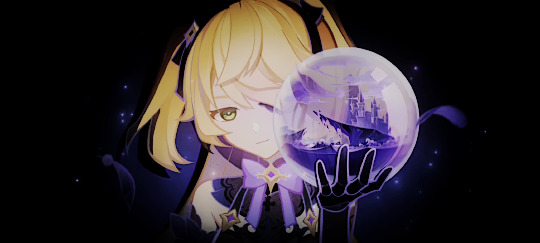
Unraveling Princess Fischl
So I recently finished studying Princess Fischl in a lab and the results I got were kinda crazy.
As a disclaimer, I do this just for fun. I like connecting dots and solving puzzles. But I'd rather you draw your own conclusions. In this post I will try to dissect the mysteries surrounding the Prinzessin. And you really can't talk about Fischl without including Kaeya. I've even got a surprise guest star for you.
WARNING: this post is VERY long, click on that Read More at your own risk, otherwise you'll be stuck scrolling forever.
For simplicity's sake Princess Fischl will be referred to as Fischl while playable Fischl will be demoted to F.
PART 1: MIDSUMMMER NIGHT'S DREAM
Most of this will use the books Legend of the Shattered Halberd and Flowers for Princess Fischl as a source. These books are authored by someone named Mr. Nine. The books are published by Yae Publishing House. So keep in mind there's a non-zero percent chance Mr. Nine is actually just a certain Nine-Tailed Fox.
F's alternate outfit is called Immernachtstraum. This is a reference to Shakespeare's play Midsummer Night's Dream. In German the play is called Ein Sommernachtstraum. So you can see the similarities (Immernachtstraum means Eternal Night's Dream.)
Kaeya is in part based on the Indian changeling prince from the same play. The character Oberon, the Fairy King, is the french derivative of Alberich. The play itself is basically about people getting into Shenanigans so absurd it might as well be a dream. Oberon and his wife Titania are actually key players in quite a bit of different media… But as much as I want to delve into that, this isn't a Kaeya post.
Just remember for now that Titania is the Fairy Queen.
In the book Flowers for Princess Fischl, there is a mention of a Sommernachtgarten. It is described as a Domain possessed by someone highly skilled in the magical arts. Sommernachtgarten seems to have existed in Teyvat. The domain Midsummer Courtyard, which has the Thundering Fury set, tells us the Sommernachtgarten was buried underground.
The domain is located in Starfell Valley. It's nearby Starfell Lake and Starsnatch Cliff. Starfell Lake is said to have been formed by a fallen star.
Fischl is also equated to a star that fell down. Notably, in F's birthday letters, and in Legend of the Shattered Halberd.
Birthday Letter: Day of Destiny…
On the day of a sacred star's descent from the depths of the night sky into this realm, I, the Prinzessin der Verurteilung, have asked Oz to cross the ocean and bring, me exotic treasure.
LotSH Vol. 1
The story was that an iron meteorite had fallen from the sky five or six years ago, and convention dictated that as nature's treasure it belonged to the imperial family.


Starsnatch Cliff is the only place where Cecilia flowers grow. These flowers have a triquetra shape, which is similar to Kaeya's passive talent Glacial Heart. Kaeya has been featured with these flowers in his birthday arts, and even invites the Traveler to go see the flowers with him.
Alice: With enough bombs placed in proper positions, even huge cliffs like Starsnatch would crumble into dust in a second. With flatter terrain, Mondstadt would surely look much nicer. But that unctuous Cavalry Captain rejected my proposal instantly. He even asked me to stay away from Starsnatch Cliff.
Furthermore, when Alice proposed to blow Starsnatch Cliff up, Kaeya denied her request and warned her to never go near there again… Starsnatch Cliff also overlooks the Nameless Island which is shrouded in mist and invisible on the map.
菲谢尔 = Fischer = Fischl
Fischl's name might be a reference to the Fisher King from Arthurian legends. One name of the Fisher King is Amfortas. In the game Anfortas is the name of the Knight Marshal of the Schwanenritter; he's thee Alberich who stepped up as Regent King when Irmin was indisposed.
Perhaps Fischl was the original "Fisher King" and the kings who came after her, like Irmin and Anfortas, fulfilled her role. …But this would imply Fischl was once the ruler of Khaenri'ah. That would be crazy, right? Right, guys?
PART 2: THE PRINCESS OF JUDGEMENT
When I was analyzing the 8-pointed star, I discovered these 8 points could actually correspond to the Guardians of the Eight Directions in Hinduism.
For some reason, ascension gem stones are named after Hindu gods (with the exception of Electro). This isn't the case in the original Chinese naming however.
Still, I tried to mix and match the gemstones to a direction.


North: Kubera, The God of Fortune -> GEO
South: Yama, The God of Justice and Death -> ???
East: Indra, The Lord of Heaven and God of the Weather, Sky, Rain, and Storms -> ELECTRO
West: Varuna, God of the Seas, Oceans, and Rain -> HYDRO
Northeast: Ishana, God of Birth, Death, Resurrection, and Time -> DENDRO
Southeast: Agni, God of Fire -> PYRO
Northwest: Vayu, God of the Winds and Air -> ANEMO
Southwest: Nirṛta, God of Death, Sorrow, and Decay -> CRYO
Hydro (Varunada), Pyro (Agnidus) and Anemo (Vayuda) gems already have the same names as the Hindu gods so that was easy. The Electro gemstone Vajrada is named after a sword but it belongs to Indra, God of Weather, Rain and Storms.
That just left me with Cryo (Shivada), Geo (Prithiva) and Dendro (Nagadus). Ishana is the God of Birth, so I'll assign him Dendro. Kubera is the God of Fortune which is Geo because Mora.
Now Cryo is a bit puzzling, because it's named after Shiva, who in Java and Bali Hinduism is actually the direction in the center. Some crazy implications here for our buddy the Tsaritsa because Shiva is the God of Destruction within the Trimurti, a trinity of deities. The other two are Brahma, God of Creation and Vishnu, God of Preservation.
In Java Hinduism, Brahma and Vishnu would correspond to the directions Zenith (South) and Nadir (North). Whether this is hinting at something about the nature of the Tsaritsa is unclear. When you see Three Deities you think Moon Sisters, right? However, we can't rule out the possibility that Genshin decided to mix these deities up. Let's just spare ourselves the headache for now and forget about this. This is a Fischl analysis after all.
So instead, let's have a look at the Cryo gemstone's original name in Chinese. The stone is simply called Grieving Ice.
哀叙冰玉: Grieving Ice
Since Nirriti is the God of Sorrow, I decided to assign them Cryo. Now we are left with one deity, Yama: The God of Justice and Death. Well, it can't be Hydro, because we already assigned them to a God. So it has to be someone else.
Fischl's title is the Prinzessin der Verurteilung. Which translates into Princess of Judgement. According to Legend of the Shattered Halberd and F's voicelines, Fischl's role was to act as a judge.
More About Fischl: I
To condemn the guilty, to sanctify the just, and to draw all castaway dreams into the embrace of the infinite Immernachtreich. This is the birthright of the Prinzessin der Verurteilung, and her burden. None may gainsay it.
What's interesting is that Fischl uses magical arrows to shoot down the "enemies of fate".
About Us: Shooting Down the World Beast
Should this world, like a beast prowling in the night, covet your dreams, then I, Prinzessin der Verurteilung, shall fell it with my ensorcelled arrows of judgment!
Feelings About Ascension: Intro
My magic arrow cries out my holy name as it streaks through the night, praying that the violet lightning of retribution shall strike the enemies of fate down from the skies!
On the 8-pointed star, there's an arrow pointing upwards. Kaeya, Clothar and Halfdan's stars on their outfits and even F herself have the arrow pointing downwards.
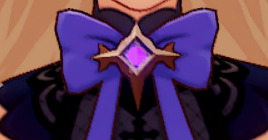

The achievement you get when you find this door is called "Abandon All Hope Ye Who Enter Here". Which is a reference to the entrance to Hell in Dante's Inferno.
The Immernachtreich is described as a place where all things will eventually flow into. Immernachtreich literally translates into Eternal Night Realm…
Flowers for Princess Fischl: Phantasmagoria
Every good, bright and noble thing must eventually fall to inexorable entropic destruction, and the final destination of the universe is the realm-in-waiting of the Prinzessin, Immernachtreich. This is the fate of all worlds, of the universe, and all who live in it.
In the Immernachtreich Apokalypse, Leon calls Fischl the Soteria.
Soteria means salvation, preservation. It's used as an epithet for Persephone and Hecate. Persephone was forcibly made Queen of the Underworld, and Hecate is also known as the Goddess of the Underworld and Witchcraft…
Look, I don't want to claim Fischl was the secret 8th Archon or anything, because lest we forget Khaenri'ah was a godless nation who would've been Fischl's enemies. But why then would Khaenri'ah have this giant star referencing the 8 deities as their emblem in the first place? Seems a bit counterintuitive. I don't have the answers for now, and perhaps the 8th "archon" was simply Irmin. Or maybe it's not even representing a god but an element or a direction.
Regarding Oz, he is a not so subtle reference to Odin/Irmin but is also a reference to the Wizard of Oz. In the first book, it was revealed this wizard was literally just some guy pretending to be powerful. Eventually Oz starts working as an advisor for the true ruler of Oz, Princess Ozma, who is the inspiration behind Fischl. We'll get back to that later.
This Oz's full name is Oscar Zoroaster Phadrig Isaac Norman Henkle Emmannuel Ambroise Diggs. OZ is actually short for Oscar Zoroaster. Zoroaster is referenced in Flowers for Princess Fischl.
In a distant causality, if the philosopher Zarathustra was not chosen, then the opera writer would have gained victory in the contest over the will of the world.
This does make you wonder if Irmin really was the true ruler of Khaenri'ah and if he even existed the way we believe he did. Perhaps Fischl got Irminsnapped and now everyone believes Irmin was always the One-Eyed King.
Of course this is all my personal speculation and I could be way off here.
Wait, before we move on to next section, I want to point out something that always gets ignored:

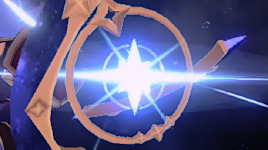
Kaeya and Mona, when they cast their bursts, summon the same 8-pointed star. This is unique to them alone. Could there be a connection between Khaenri'ah and witchcraft? Or is either Kaeya or Mona an outlier?
PART 3: HEXENZIRKEL
In the trailer Mage's Teaparty, there are eight witches shown. However, we only know the names of six witches, and there is a chair missing at the table.
There is a slideshow where the figures of the eight witches are shown, minus Andersdottir who is represented by the book The Boar Princess.
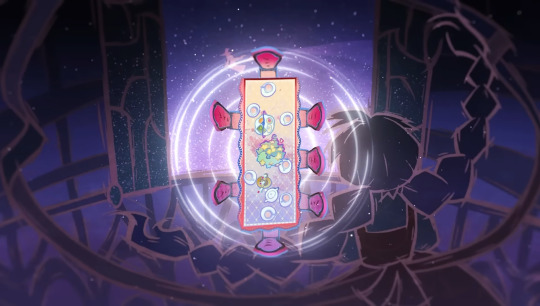
Observe the witch on the broom and the little witch. The design of the little witch is similar to the design of a famous fictional character who got pulled into another world: Dorothy Gale from The Wizard of Oz books.
Dorothy is illustrated as having twin tails and wearing a farm girl dress. Dorothy's character was influenced by the character Alice, from the Wonderland books.
Originally I assumed Alice Genshin might be based on book Alice. However, it's the Narzissenkreuz quest that's based on the Wonderland books and Mary-Ann who takes the role of Alice.
With that in mind, could Alice Genshin actually be more of a Dorothy inspired character instead?
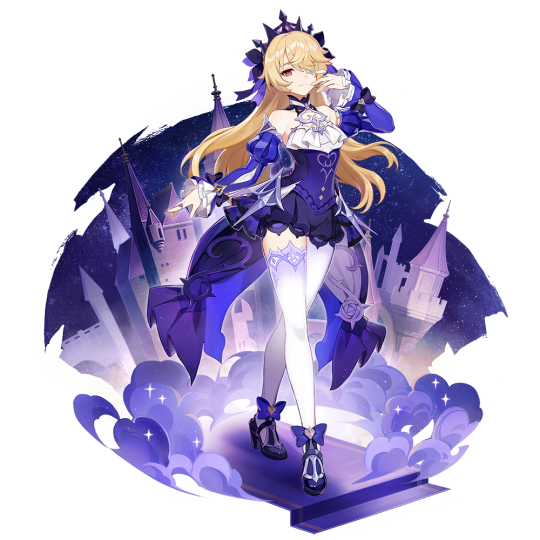

Now, Dorothy had a very good friend, called Princess Ozma. Ozma seems to be the inspiration behind Fischl.
So who is Ozma? I only have the Wiki to go on because I'm not about to read 40 books, but by the sound of it, Ozma is the current ruler of the realm of Oz. She is the daughter of a human king and a Fairy Queen. Her mother Lurline was the one who created Oz and turned it into a Fairy country.
Ozma took it one step further and separated Oz entirely from the outer realms making it invisible to outsiders. Everyone who enters Oz never ages.
If you're an F main I'm sure you know by now Fischl created another universe and founded paradise.

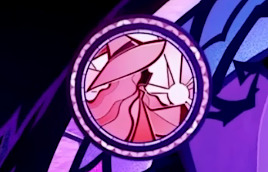
Now I want you to take a look at the witches portrayed in these circles. There are two witches holding a sphere. In F's cutscene from the Summertime Odyssey event, she is also holding a sphere which contains the Immernachtreich which you can see in the header image of this post and below.
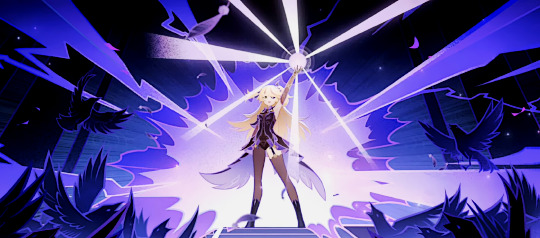
You might think a glowing sphere represents a crystal ball to scry in, but that poses a problem since known prophet Barbeloth is probably represented by the witch holding a waterdrop, which is Hydromancy. So the glowing sphere might not necessarily mean a prophetess.
As for the identity of the other witch with the globe, I believe this could be Alice, since she was the one who created the domain/dreamscape of the Veluriyam Mirage. It could also be Rhinedottir who is creating something in a flask.
So Orb = Domain/Realm/Creation
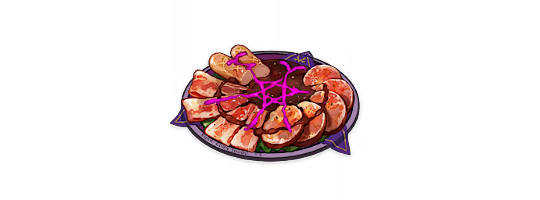
Furthermore F's specialty food is Die Heilige Sinfonie, which has a Magic Hexagram painted on top… (Die Heilige Sinfonie translates into The Holy Symphony.) As mentioned before, the Sommernachtgarten could only be created by someone with great magical powers…
Magic Circles is Ceremonial or Arcane Magic, and according to a note left by Master Ruggiero in Bravais' study, Arcane Arts originated from a pre-Remurian civilization.
So someone must have taught humans magic. Might sound obvious, but it begs the question of WHO?
PART 4: FREYJA
To answer this question we need to dip our toes into Norse mythology. As you know, Odin is Irmin.
There was a war between two groups of gods: the Aesir and the Vanir.
Eventually they had enough and decided to exchange hostages as a peace offering. The goddess Freyja, originally part of the Vanir, joined the Aesir which would be Odin's group. As a sacrificial priestess, she was the one who taught the Aesir dark magic, which included seeing into the future. The implication here then is that Odin was taught black magic by Freyja.
This magic is known as seiðr. Seiðr is derived from *soi-to- which means rope/string. The distaff, a tool used for spinning wool, is associated with dark magic. There are images of women riding distaffs as a broom, similar to a witch riding a broomstick. To quote the Wiki: "In any case, the string relates to the "threads of fate", that the Nornir spin, measure, and cut. " Wait, that sounds familiar:
F, joining the party voice line: The threads of your fate lie in my hands!
Scholars suspect Freyja is the same person as Gullveig who was involved in the Aesir-Vanir war. Gullveig was attacked by the Aesir with spears; she died and was reborn three times. When Fischl tried to visit the Kingdom of Eternal Twilight she was also attacked by its people and "shed her blood on the sacred emblem" whatever that means. It was Oz who saved her, pledging his loyalty to her.
Freyja sometimes is conflated with another goddess named Frigg. There has been much debate whether or not these two goddesses stem from the same deity. Frigg is part of the Aesir and usually Odin's wife.
I mention this because in the book Hex and Hound, one of the characters is named after Frigg: Nottfrigga. This book is about two twin witches sharing the same body. In the book we find out that they were the daughters of a powerful witch, but witches are unable to keep more than one offspring of the same generation. This led to Nottfrigga's twin sister Magdalene eventually dying, and her using magic to sustain her sister inside a magic bracelet.
In Norse mythology, Nott is the personification of night. Nott's father is named Narfi. This really got my attention, because Fischl's full name is Fischl von Luftschloss Narfidort. (Fischl of the Castle in the Sky Narfidort.)
In the Hexenzirkel teaser, every witch is represented by a teacup (or in the case of Andersdottir, an inkbottle) but the saucer next to Nicole's teacup is empty. Since this saucer belongs to the same teaset this could mean one of the missing witches is Nicole's twin sister or a relative.
So what could Fischl's role be in all this? Perhaps she's one of the twin sisters, or their mother. Perhaps she's even an ancestor. ...Or completely unrelated to them and I'm full of shit.
PART 5: THE HARBINGERS
F's theme shares a leitmotief with the Fatui Harbingers theme.
F's theme: Sieh an, mein Sommernachtgarten!
Signora's theme: Saltatio Favillae
Obviously this means Fischl is Capitano.
Composers don't do these things by accident. This is hinting at something. Either Fischl is connected to the Harbingers, was/is one of the Harbingers, or she is indeed the Tsaritsa.
Which is not as crazy as it sounds.
In Legend of the Shattered Halberd, Fischl possessed someone else's body. And if she is Freyja's equivalent, who died three times, then it's possible she could've been reborn as someone else. In the book, it was Mir who summoned Fischl into Weiyang's body and sacrificed his eye to appease her. Pierro is working for the Tsaritsa and has his right eye covered for reasons unknown. Having been a royal mage who would have had access to Khaenri'ah's restricted library, perhaps it was Pierro who summoned Fischl into the Tsaritsa's body.
The Tsaritsa is collecting the seven Gnoses, Fischl had to collect seven of the nine Ominous Swords to repair the Divine Halberd, which would be herself. She already had two of them in her possession… Could also be that the Tsaritsa is trying to revive her. This would imply Fischl is the Third Descender. Since she came from another world, this is not impossible.
The Fisher King, Fischl's possible namesake, was struck with a wound that could only be healed by a "pure fool" who would ask him the right question. ...Fatui is Latin for fools. If the Tsaritsa really is/is possessed by Fischl, then creating an organization of fools starts to make sense: the fools are her saviors.
This could also connect to the empty 10th seat within the Harbingers. The vacant spot could be a reference to the Siege Perilous, which was an empty seat reserved for the one successful in obtaining the Holy Grail by way of saving the Fisher King.
Usually this is accomplished by Percival, who later finds out his mother is the sister of the Fisher King. In the story, Percival keeps failing to return to the kingdom of the Holy Grail since it is an otherworldly place. Does that not remind you of Kaeya trying to find Khaenri'ah but failing halfway through?
Going back to Princess Ozma, an evil witch cast a spell on her that turned her into a little boy named Tippetarius. This was done to prevent Ozma from ascending to the throne. Tip was unaware of his true identity until he was transformed back into Ozma.
tippet /tĭp′ĭt/ noun
A covering for the shoulders, as of fur, with long ends that hang in front.
As noted in The Marvelous Land of Oz, Chapter 23, Tip has brown colored skin.
…Kaeya, blink twice if you need help.
As a staunch hater of things that don't make sense, I highly doubt this means Kaeya is Fischl; the game would never go there. Perhaps being "Fischl" is simply hinting towards the fact that he will become one of the Fisher Kings.

That would certainly explain this random hangout ending.
Now, here's where things get really crazy.
Remember Anfortas? The Knight Marshal of the Schwanenritter who took over as regent after Irmin became indisposed? At the time of writing, Anfortas's fate remains unknown.
As said before, Anfortas is the name of the Fisher King in Arthurian legends. Fischl's name might've been a nod to that.
But it gets weirder.
T.S. Eliot's poem The Waste Land combines Arthurian legends with the legend of the Fisher King. In it, he associates the Fisher King with the tarot card Three of Staves.
The Man with Three Staves (an authentic member of the Tarot pack) I associate, quite arbitrarily, with the Fisher King himself.
…We have seen this symbol somewhere before. On the constellation wheel of the Fatui Harbingers. By process of elimination this constellation belongs to Il Capitano.
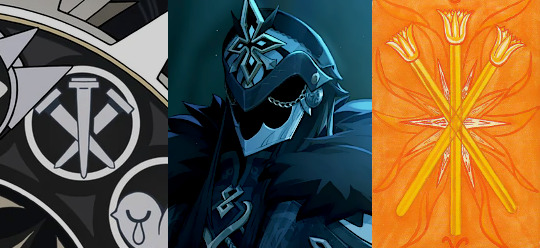
👏🏽👏🏽CONGRATULATIONS CAPITANO YOU ARE KAEYA'S NEXT TOP GRANDPA 🎉
Kidding of course, but I doubt this is a coincidence. This doesn't necessarily mean they are the same person, maybe Capitano simply mindmelded with Anfortas. It's a fantasy game, everything is possible at this point.
Wait a minute… three nails, three deaths… Uhhh maybe Fischl really did turn into Capitano.
👏🏽👏🏽CONGRATULATIONS CAPITANO YOU ARE PRINCESS DIANA'S NEXT REINCARNATION 👸🏼
PART 6: THE THIEF AND THE MAGE
Alright, for this section I want us to keep in mind the following things:
Fischl is a fallen star
Fischl may have been a mage
Fischl could be connected to Irmin and thus Khaenri'ah

The play of the Veluriyam Mirage is written by Zosimos. This play stars Kaeya as a Thief, Klee as a Mage and Idyia as a last minute heroine added to the story.
You see, Zosimos originally wanted to write a story based on rumors he'd heard about a thief and a mage. This means the play might not be entirely fictional. The problem is that Zosimos combined Idyia's backstory with the story of the Thief and the Mage, making it hard to tell which bits belong to Thief's story.
We know at least that Alice was the mage who helped Idyia. But what about the Mage who helped the Thief? Who was she? Could it have been Alice or someone else?
For that we need to consider the character Kaeya was playing. It's unknown who he is, but if Klee was playing her mom then it stands to reason Kaeya must've been playing someone connected to him. Before you get excited, this does not necessarily mean someone related to him by blood. Could also just be someone from Khaenri'ah. Heck, we don't even know the gender of the mage, for all we know they could've been a man.
Now, the soundtrack that plays during Kaeya's part is called Towers of Afrasiab. This name has come up before. In the play of Kaeya's hangout, the character he plays opposite of is called Frasiyav. The location of the Khaenri'ahn door is called Hangeh Afrasiyab.

I personally suspect Afrasiyab is either Irmin or the founder of Khaenri'ah.
Afrasiyab is a character from the Persian epic, the Shahnameh. Afrasiyab lived in an underground iron palace held up by hundreds of columns. (If you look at the architecture in Hangeh Afrasiyab, you'll see little reliefs of men holding up a ceiling above them.) Afrasiyab lacked the divine royal glory known as Khvarena and was obsessed with obtaining it. In the play they say Frasiyav lost because he lacked the blessing of god…
I mean it can't get any more obvious than that. So this could mean the dude from Kaeya's hangout was Irmin. Which does raise a bunch of questions, such as who is the identity of the Prince in this play? And why were they at war?
Should be noted in the hangout's play, Frasiyav offered hostages as a peace offering. Kind of reminds me of the war between the Aesir and Vanir… Also, Kaeya's character Prince Qubad is based on Siyavash who eventually married into Afrasiyab's family…
Towers of Afrasiyab then could refer to Khaenri'ah. In the Veluriyam play, the Thief is also from a dark realm. I hesitate making the assumption that this guy is Irmin or Kaeya's pirate grandpa so I will refer to him as simply the Thief.
In the play, the Thief witnesses a shooting star falling from the sky and follows it. However, what he finds is not a star but a young woman. Well, we know Fischl was also a star that fell down. And we know Fischl visited the Kingdom of Eternal Twilight and got bodied for her efforts. Oz took her under his wings and saved her life.
If the Thief encountered the Mage this way it would explain why the Mage helped him as a way to repay him. Perhaps the Mage taught him Arcane arts or helped him protect the "Dark Realm", who knows?
If this Mage really was Fischl and the Thief someone connected or related to Kaeya it would explain why Fischl and Kaeya seem to be connected.

About Kaeya
F: His nature is obscure, his fate a mystery, and his speech a vexing tapestry woven of both fact and fiction… Perhaps he and I share the burden of mystical sight…
About Fischl
Kaeya: Hmm? You think Fischl having one eye covered is very fitting given her title of Prinzessin der Verurteilung. Hahaha, if that's the case, that must also make me a descendant of some kind of former royal lineage, no?
Furthermore, in Legend of the Shattered Halberd, Fischl's partner in crime, the man who summoned her, is named Mir. This is a reference to Mimir, the severed head from Norse mythology who acted as an advisor to Odin.
Mr. Nine states Fischl was attracted to Mir… and that Oz was more of a familiar of Fischl.
In Wagner's opera Der Ring des Nibelungen, Mimir is known as Mime, the brother of Alberich.
....😮💨
Well, I have to say, even after all of that, I am completely stumped. If anyone knows what's going on, let me know, because I for one would love to know WHAT'S GOING ON FOR ONCE. GIVE IT UP FOR KNOWING WHAT'S GOING ON
40 notes
·
View notes
Text
firefox tabs i have open:
tumblr
tumblr notes
one of my mutuals' blog archive4
my own blog archive
five posts ive reblogged
google image search for 'aardwolf'
a tumblr devoted to j.c. leyendecker
a post from 2017 on my old blog about a stand i made (my friend wanted fanstands to try drawing)
five e621 tabs
an ultima iv-v-vi screenshot lp
"morrowind: an oral history" from polygon
online minesweeper site
online solitaire site
wikipedia page for "Aeon"
wikipedia page for "Young's Literal Translation"
wikipedia page for "Chicxulub crater"
wikipedia page for "Axis mundi"
wikipedia page for "Mount Rainier"
itch.io
sword interval
scryfall search "type:dragon"
scrayfall "Ambitious Dragonborn"
mychart login
http://psd.museum.upenn.edu/epsd/e4129.html
google spreadsheet i made to keep track of silly names i made up in case i wanted to name characters in anything
menu for a local teriyaki restaurant
gmail
anime streaming site tabs for Moribito: Guardian of the Spirit, Spirited Away, and Princess Mononoke
cohost
cohost notes
Just King Things episode on The Waste Lands
Just King Things episode on The Tommyknockers
wiktionary page for "audient"
wikipedia page for "Banana"
wikipedia page for "Robert W. Service
wikipedia page for "Li (unit)"
wikipedia page for "Invertebrate iridescent virus 31"
GameFAQs walkthrough and map for Dragon Warrior for the NES
twitter
twitter notes
metropolitan museum of art page on some Qing dynasty agate pomegranates
wikipedia page for "William Howard Taft"
wikipedia page for "Wig"
wikipedia page for "Egyptian cuisine"
google doc where i was trying to transcribe every JKT five-sentence summary
Kill Six Billion Demons KSBD 2-27
Kill Six Billion Demons Breaker of Infinities 4-181
letterboxd
The New Whirling School: An annotated analysis of Sermon 01
youtube subscriptions
youtube Deadmau5 - Ghosts n Stuff
youtube Ranged Touch's 2021 Dark Souls 2 charity livestream part 1
youtube Ranged Touch's 2020 Morrowind charity livestream part 1
youtube Northernlion playing Slice and Dice
youtube Vangelis - Blade Runner Blues
youtube Lady Gaga - Just Dance
youtube Northernlion playing Enter the Gungeon
youtube The Killers - Human
youtube Kanye West - Flashing Lights
manga site for Berserk and Blame!
nine tabs of the Terraria wiki
wikipedia page for "Etruscan civilization"
google search for "forestall"
wikipedia page for "Ran (film)
scryfall search "type:goblin color>=b"
wikipedia page for "Gisella Perl"
wikipedia page for "Overtone singing"
wikipedia page for "Muezzin"
About Us page for Gay City: Seattle's LGBTQ Center
an entirely unused new tab
"An Unknown Kid on Halloween"
uquiz results for "what's your job after the apocalypse"
wikipedia page for "Barnacle goose myth"
wikipedia page for "Vegetable Lamb of Tartary"
rom site
what happens next
youtube William Wegman - Alphabet Soup
events page for a seattle comics & games shop
youtube Ode to Physical Pain
google search for "hyperobject"
prisoncensorship's review of Fallouts 1 & 2
picture i took of the inside of that same comics & games shop
wikipedia page for "Infliximab"
chart showing the evolutionary tree of polearms over time
another mutual's reblogged post
two tabs of the menu of a local pastrami shop
pdf of the third edition monster manual
wikipedia page for "Forgotten Realms"
picture i took of my own backyard covered in snow
scryfall search "set:clb t:dragon is:firstprint"
scryfall search "set"afr t:dragon"
three tabs of file directory for some tabletop pdfs
wikipedia page for "First Blood"
youtube King Missile - Open
someone's website about cat colorations and fur patterns
image a friend sent me of the chapter list of the novel she's writing
Gita Jackson's article comparing Dwarf Fortress and Rimworld
download page for the roguelike "Infra Arcana"
youtube Richard Dawson - Ogre
youtube Every Enemy in Dark Souls RATED - 1 - Undead Asylum
an Exalted 2e homebrew Hegra charmset
a friend's twitter
bilibili video for known Genshin Impact character Xiao
google doc of the rules for a discord server im in
i know i have way too many tabs open please dont yell at me
18 notes
·
View notes
Photo
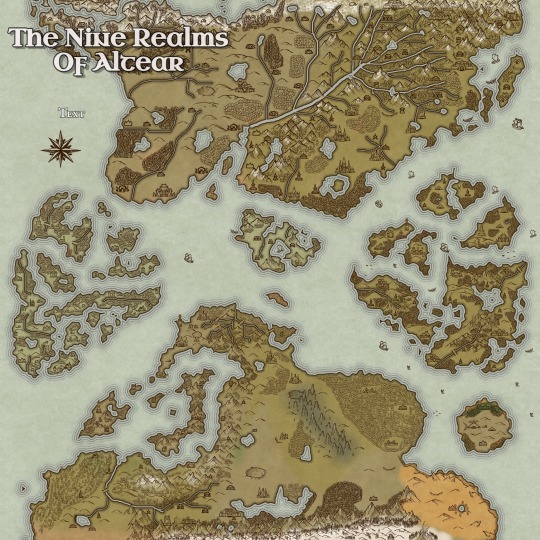


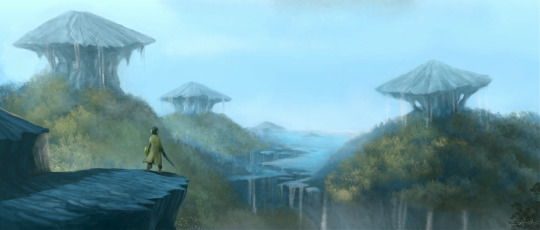
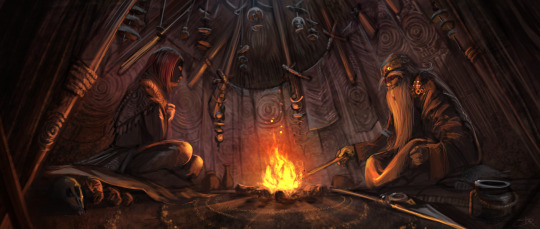

The above art not including the map is by David Revoy and is being used for creative commons means. I claim no ownership of it. The map was made with Inkarnate.
---
The official introduction overview for my new High Fantasy setting the Nine Realms, is now up on Patreon! Where it will remain for a week (which you can access for $1) where then it’ll become accessible to everyone on my Discord.
Here is a little taste of the new lore on Altear:
Known by many names including: "The Otherworld," "Arcadia," "Faerie" and "Elfland", the Nine Realms of Altear (shortened often to Altear or the Nine Realms) is a world of eldritch mystery and horror. Untold billions of years old, Altear awoke when the Stars were young and any form of Earth was but dreams in the eyes of unnamed Gods. Upon it were born God's, Legends and unfathomable Horrors. From the scattered myths of mortals, some facts can be ascertained about the Nine Realms. The Gods, the Titans, and the Primordials of Creation were born here, and where the Fae descend.
#queer fantasy#fantasy#gay fantasy#lesbian fantasy#trans fantasy#high fantasy#faeries#fair folk#fairfolk#fae#lgbtqia#lesbian#gay#bisexual#bi#les#le$bean#trans#transgender#nonbinary#mtf#ftm#transmasc#transfemme#enby#gender nonconforming#transwoman#transman#the binary is a literal lie!
7 notes
·
View notes
Text
Regarding management , you can learn:

Mr. Liang Ning who got the App’s HE Tuber and [Growth Thinking]: strategic choices of points, lines and surfaces, classic user portraits, scenarios and empathy, user experience maps and service design blueprints, three-stage rockets, etc.;
Jen Carlson’s [Critical Moments MOT] (can be paired with Wang Zhiqian’s [MOT Experience Design Course] in [Get App]): Based on customer orientation, complex business operations are broken down into critical moments one by one (similar to user experience Map), and ultimately realize the company's turnaround;
Meadows’s [The Beauty of Systems], [Loss of Control], Liu Run’s [30 Lectures on Business Insights], and Li Xigui’s [How Schools Work]: the core are all centered around systems theory, which can provide a solution when seeking solutions. methodology;
Regarding product principles , you can learn:
Redamio's [Principles]: such as embracing reality, dealing with reality, extreme truth-seeking and extreme transparency. What is more important is to learn its way of thinking, which is to simplify complex investment logic into clear principles and act according to the principles;
Xiaomi’s [Xiaomi ecological chain footprint notes]: 80%-80% principle, err on the side of reducing work and adding more, being right first before being surprising, doing less in order to be more precise, etc.;
Regarding work methodology , you can learn:
Stephen Covey’s [Seven Habits of Highly Effective People]: Be proactive, start with the end in mind, put first things first, win-win thinking, know your enemy and understand yourself, integrate synergy, and constantly update;
Atul Govender’s [List Revolution]: A small list can solve complex projects. For example, how to reduce patient mortality caused by improper operations;
Jack Welch's "Winning" and "The Nature of Business";
[The Effective Manager] by Peter Drucker;
Kazuo Inamori’s [Lifestyle], [Mindstyle] and [Management Philosophy]
Get App【Measurement·Team Management 20 Lectures】
Methodology is not omnipotent, nor is it 100% correct (Newton's three laws may also be invalid), let alone rigid copying (methodologies may be mutually exclusive).
This is just like when Zhang Sanfeng taught Tai Chi to Zhang Wuji, he asked him to forget all the moves and martial arts and he would learn it naturally. The methodology is like the [Nine Yang Divine Art], [Star Absorbing Technique], etc. that Zhang Wuji learned. In the end, if you want to become Zhang Sanfeng, you still have to forget them. You just need to focus on practicing, and you can use different tricks and mental methods. Maybe it will flow out naturally. This is the realm we should pursue.
In the book [Marketing Notes], marketing expert Xiao Ma Song has a point of view: The success of an enterprise is fundamentally the success of business logic (rather than the success of methodology) . For example, if Nancheng Xiang follows the [positioning theory] (use positioning to occupy the category and influence the user's mind), then it may not be established (it also sells soy milk and fried dough sticks, rice bowls, wontons and mutton skewers). If you follow the basic logic of business operations: improve efficiency and reduce costs, then it is established, because this model is based on [user needs] and increases the frequency of consumption to achieve an improvement in square footage.
To sum up: the basic logic of business operations is greater than methodology. In the same way, the practical logic of the product is greater than the methodology itself. This is like following the methodology of "stop on red light, go on green light". It is definitely good, but even if the light is green, you still have to look up and don't walk past if there is a car.
Finally, I will add a few existing cases (cases will continue to be updated in the future, but it may be slow) for reference:
columnist
Xing Xiaozuo, WeChat public account: Xing Xiaozuo’s home, everyone is a product manager columnist. An online education product that focuses on Internet education and likes to study user psychology.
0 notes
Text
Write at the end

Mr. Liang Ning who got the App’s HE Tuber and [Growth Thinking]: strategic choices of points, lines and surfaces, classic user portraits, scenarios and empathy, user experience maps and service design blueprints, three-stage rockets, etc.;
Jen Carlson’s [Critical Moments MOT] (can be paired with Wang Zhiqian’s [MOT Experience Design Course] in [Get App]): Based on customer orientation, complex business operations are broken down into critical moments one by one (similar to user experience Map), and ultimately realize the company's turnaround;
Meadows’s [The Beauty of Systems], [Loss of Control], Liu Run’s [30 Lectures on Business Insights], and Li Xigui’s [How Schools Work]: the core are all centered around systems theory, which can provide a solution when seeking solutions. methodology;
Regarding product principles , you can learn:
Redamio's [Principles]: such as embracing reality, dealing with reality, extreme truth-seeking and extreme transparency. What is more important is to learn its way of thinking, which is to simplify complex investment logic into clear principles and act according to the principles;
Xiaomi’s [Xiaomi ecological chain footprint notes]: 80%-80% principle, err on the side of reducing work and adding more, being right first before being surprising, doing less in order to be more precise, etc.;
Regarding work methodology , you can learn:
Stephen Covey’s [Seven Habits of Highly Effective People]: Be proactive, start with the end in mind, put first things first, win-win thinking, know your enemy and understand yourself, integrate synergy, and constantly update;
Atul Govender’s [List Revolution]: A small list can solve complex projects. For example, how to reduce patient mortality caused by improper operations;
Regarding management , you can learn:
Jack Welch's "Winning" and "The Nature of Business";
[The Effective Manager] by Peter Drucker;
Kazuo Inamori’s [Lifestyle], [Mindstyle] and [Management Philosophy]
Get App【Measurement·Team Management 20 Lectures】
Methodology is not omnipotent, nor is it 100% correct (Newton's three laws may also be invalid), let alone rigid copying (methodologies may be mutually exclusive).
This is just like when Zhang Sanfeng taught Tai Chi to Zhang Wuji, he asked him to forget all the moves and martial arts and he would learn it naturally. The methodology is like the [Nine Yang Divine Art], [Star Absorbing Technique], etc. that Zhang Wuji learned. In the end, if you want to become Zhang Sanfeng, you still have to forget them. You just need to focus on practicing, and you can use different tricks and mental methods. Maybe it will flow out naturally. This is the realm we should pursue.
In the book [Marketing Notes], marketing expert Xiao Ma Song has a point of view: The success of an enterprise is fundamentally the success of business logic (rather than the success of methodology) . For example, if Nancheng Xiang follows the [positioning theory] (use positioning to occupy the category and influence the user's mind), then it may not be established (it also sells soy milk and fried dough sticks, rice bowls, wontons and mutton skewers). If you follow the basic logic of business operations: improve efficiency and reduce costs, then it is established, because this model is based on [user needs] and increases the frequency of consumption to achieve an improvement in square footage.
To sum up: the basic logic of business operations is greater than methodology. In the same way, the practical logic of the product is greater than the methodology itself. This is like following the methodology of "stop on red light, go on green light". It is definitely good, but even if the light is green, you still have to look up and don't walk past if there is a car.
Finally, I will add a few existing cases (cases will continue to be updated in the future, but it may be slow) for reference:
columnist
Xing Xiaozuo, WeChat public account: Xing Xiaozuo’s home, everyone is a product manager columnist. An online education product that focuses on Internet education and likes to study user psychology.
0 notes
Text
world famous astrologer in india
World Famous Astrologer in India: Unraveling the Cosmic Mysteries
Introduction
Astrology, an ancient and revered art, has been an integral part of Indian culture for millennia. With a rich heritage and a lineage of world-famous astrologers, India has been a beacon of cosmic wisdom, guiding people on their life journeys. In this article, we embark on a fascinating exploration of astrology and its connection to India, shedding light on the illustrious world-famous astrologers who have left an indelible mark on the celestial realm.
1. The Timeless Appeal of Astrology
Astrology, a profound system that connects the position of celestial bodies with human life, has fascinated people across the globe. The allure of astrology lies in its ability to offer insights into personality traits, relationships, career paths, and life events. Millions turn to astrology in search of guidance and self-discovery.
2. Indian Astrology: A Divine Connection
India, renowned for its spirituality and ancient wisdom, holds a deep reverence for astrology. Indian astrology, also known as Vedic astrology or Jyotish, is rooted in sacred texts and scriptures, making it a divine connection to the cosmos.
3. The Pillars of Indian Astrology
Indian astrology is built upon four pillars: Sidereal Zodiac, Twelve Houses, Nine Planets, and Dasha System. These pillars form the backbone of astrological predictions, creating a comprehensive and accurate framework.
4. The Legacy of World-Famous Astrologers
India's illustrious history is adorned with the names of world-famous astrologers who have graced the nation with their extraordinary insights. From Varahamihira to Aryabhata, from Bejan Daruwalla to Pt. Jawaharlal Nehru, these luminaries have shaped the course of astrology and influenced generations.
5. Astrology in Daily Life
Astrology is not just about predicting the future; it offers practical advice for daily life. From auspicious timings for important events to remedial measures for overcoming challenges, astrology becomes a trusted companion in navigating life's uncertainties.
6. Spiritual and Scientific: The Dual Nature of Astrology
Astrology, blending spiritual and scientific elements, bridges the gap between the material and the metaphysical. It instills a sense of wonder, enabling individuals to comprehend their unique place in the cosmic tapestry.
7. A Cosmic Map: Birth Charts and Horoscopes
At the heart of astrology lies the birth chart or horoscope, a cosmic map of an individual's life. It captures the positions of planets and their influence on various aspects of life, guiding seekers on their destined path.
8. Astrology's Influence on Relationships
Astrology extends its reach to relationships, providing valuable insights into compatibility and understanding between individuals. Couples seek astrological advice to foster harmony and strengthen their bond.
9. The Digital Age of Astrology
The advent of the digital era has transformed astrology's accessibility. World-famous astrologers in India have embraced technology, providing personalized readings, online consultations, and astrological content to a global audience.
10. Navigating Life's Journey with Astrology
Astrology is not a means to alter destiny but a tool to comprehend it. The wisdom of world-famous astrologers in India lies in their ability to inspire individuals to embrace their life journey with resilience, gratitude, and a deep connection to the cosmos.
Conclusion
Astrology, intricately woven into the fabric of Indian culture, continues to captivate hearts and minds worldwide. Its timeless appeal, combined with the legacy of world-famous astrologers in India, makes it a cherished and revered art. As seekers and believers turn to the stars for guidance, the celestial realm bestows its wisdom, illuminating the path of life's great journey.
https://www.sundeepkochar.com/

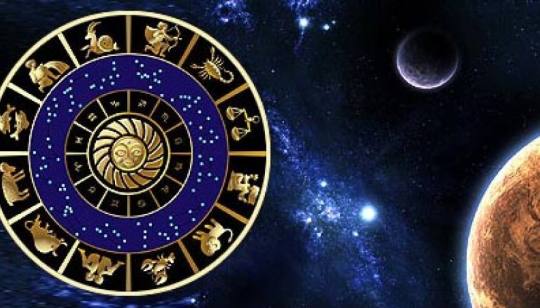
#Top astrologer in india#top astrologer#Top 10 astrologer in india#best astrologer#Best astrologer in Mumbai#Best astrologer in india#best astrologer in world
0 notes
Text

This week we begin my long reign of worldbuilding diatribes with the universe of Arturium. A pretty big overhaul project that nonetheless features a number of familiar concepts, including several you've already noticed yourself. I unfortunately don't really have concept art for most of the planes so you'll have to settle for lengthy text wall.
Pretty much all the inner seven planes are D&D-centric and I kept the Nine Hells and the Abyss because I kind of like them, but much of the rest is different. First let me draw attention to the line right at the top there - The Watchman's Eye. The layout of this planar network isn't a coincidence - the world functionally resides within the eye of an eldritch being. Very little is known about it - next to nothing besides the name in fact. Its actions, if any, have been passive and generally non-destructive to reality and the full scope of its motives aren't known by any (except myself) except for one thing: All of its disciples and followers have been known to hunt and destroy other aberrations, suggesting some form of hostility with them. To consider it a 'plane' though is a difficult thing - one could theoretically enter the body of this multidimensional being as kind of plane, but it hasn't been achieved as of yet.
But to the more comprehensible parts of the setting, it's divided into seven functional categories. Primordial Chaos, the Divine Realm, the Divine Duty, Realm of the Council, the Inner Wheel, the Lower Bridge, and the Abyss.
Primordial Chaos in the planar sense has a similar role to the watchman in that it's the part of the setting that encircles and contains all the rest like a vast ocean. Served by the various ethereal parts of the map, they are varying degrees of passively hostile to mortals and outsiders alike, as they are shaped by collective thought and are themselves composed of raw reality shaped in various ways by the planes it borders and its distance from the core material plane. It's the hardest to travel to the uninitiated but is nevertheless home to a number of more primitive planar species. The further one gets from the material the more wild and destructive the primordial seas are with the exception of the Archipelago, where a number of islands have been formed from pure will and is believed to be the stuff of the goddess of time herself.
The upper planes are then formed into three effective tiers as you can see. Each of the upper planes is home to one or more gods as a rule. At the top is the Divine Realm, where four gods reside. Romona & Ville, Elof, Nemesis and Ahlai, in theory the most powerful of the gods but more practically, the gods with the least form and most removed from mortality. The Divine Realm is typically depicted as a colossal tree of red leaves sat amidst a vast field but in fact every part of it is pure concept - there is no physical substance to it, making simply existing in the plane often fatal for its numerous non-natives.
Below it is the Divine Duty, three realms of a total of seven gods. Yetta, Moaven, Runa, Ahram, Giliam, Imeld and Sirona. With the first three considered the lords who shaped the world, the Divine Duty has effective control over the laws that underpin all reality. Their realms are at least semi-solid but often changed to suit purposes from moment to moment. And yet it sees the highest mortal traffic, for all mortal souls pass through the Household upon death regardless of their ultimate destination. As demonstrable in the Divine Duty, the look of an upper plane is always morphed and defined by the deities who occupy it, making the Household the most divided in design as it's shared between three.
The last set of upper planes is the Domain of the Council, the Council of the Flawed being those gods whose domains are typically comprised purely of mortal concepts. As they lack connection to a base law of reality they are lesser in authority, but with greater connection to mortals and their actions they tend to have more power to actually affect the world on a day to day basis. Ranging from desolate, blasted wastelands to a large yet cosy estate, all of the planes bar one is ruled over by a pair of gods with the fortress and hearth occupied by cooperative gods, and the towers and rubble the result of warring faiths. At the centre sits the Graveyard, a dead and empty plane and monument to a fallen god. The only one of its kind.
In the centre of the eye is a fairly well-known set of planes. Material, Feywild, Shadowfel, and the four elemental planes. The material is the subject of last week's piece and currently has too much to summarise here. The key information to take in about the inner planes is that all of them except the Shadowfel are inhabited by civilised races, with the Giants and elementals taking the elemental planes and of course the Fey ruling the Feywild. This is probably the biggest planar holdover and one of the hardest for me to change, though sometimes I consider alternate elemental planes.
The seven planes that compose the Lower Bridge lack the same themes as each tier of the upper planes. In fact, not all of them are openly hostile. They are as a result more diverse though, with the Nine Hells being fairly well-known courtesy of D&D and Dante's triology. Thrall's Respite is a quiet microcosm of pocket worlds that keep people safe, but it's sharing a bridge with Varachon where things rejected by the world go and Alochia, a plane that's semi-sentient and parasitic. The Nine Hells is by far the most substantial, not only for its previous place in the world but also as a planar bulkwark against the Abyss.
Then, my Abyss. I was inspired somewhat by the descriptions of the Abyss in Dark Souls lore - the gnawing beasts, where the dregs of the soul sinks. As a result, a place deep into the ethereal depths where concept often reigns, causing it to have less explicit shape than the rest and take on the general symbolic representation of a deep sinking pit. The beings that form in the Abyss are thus myriad and unpredictable, but universally formed of the darkest parts of things. The Abyss is a lightless place, and those formed within it are burdened with a desire for light, causing them to scale out of it toward the worlds above.
And with that, I think a very brief summary of all the planes has been completed. I realise these first two posts about this stuff have been kinda vague...but we'll be going into more detail with them in future posts. Next week will be something a little different though.
0 notes
Text
Unique Showpieces for Your Living Room - Satguru’s
Introduction
The living room is considered the most important room in any house. It is a room where all family members gather after a busy day to relax and talk about their day. It is believed that a well-decorated space generates positive vibes, which are important to create that relaxing and comforting atmosphere.

Showpieces are a great way to bring charm and elegance to your living area while also expressing your originality and creating a focal point. Showpieces come in a variety of shapes, sizes, and styles, ranging from sculptures and vases to decorative accents and artwork.
In this blog, we will delve into the realm of showpieces for the living room and suggest some showpieces from Satguru’s that can be an excellent addition to your living room.
Showpieces you can buy for your living room from Satguru’s
Satguru’s is a decor shop based in Mumbai that has an amazing collection of home decor items, including showpieces. They are one of the best home decor online shopping platforms in India that sell decor items at affordable rates. Here is a list of nine different showpieces that you can buy for your living room:
1. Love Bird on Branches: This love birds on branches in a round circle can be a cute addition to your living room. Birds are a symbol of love and freedom, and they can add a warm and modern feel to your living room.
2. Meditating Astronaut: This cute little thing can become your kids favourite decor item. Made from resin, this piece shows an astronaut meditating on the moon. Buy this NOW as it gets out of stock in the blink of an eye.
3. Modern Radha Krishna Sculpture: This sculpture is a modern spin on the classic Radha Krishna story that shows their lives intertwined with each other. This piece can be an ideal addition to your living room. It can also be the perfect wedding or housewarming gift.
4. Standing Namaste Monk: This piece is a sculpture of a little monk Buddha. This adorable piece can be placed on your coffee table or work table.
5. Sleeping cat: This one is special. This cat art piece is made with such precision that the cat looks alive. This piece will steal your heart if you are a cat lover. The sleeping cat looks adorable and has a feeling of calmness and relaxation. A great addition for your living room.
6. Saira World Map: This art piece is for travellers and wanderers. This beautiful world map will definitely add charm to your living room. Close your eyes, put your finger on the art piece, Bravo! You have found your next travel destination.
7. Semi Precious Rose Quartz Tree: Rose quartz is an excellent crystal for attracting your soulmate. It can make a lovely showpiece in the shape of this lovely tree. This can be a great addition in your living room.
8. Elephant Ear/Mouth/Eyes Closed: This piece portrays Gandhiji's principles of "hear no evil, speak no evil, and see no evil." Except instead of monkeys, there are three adorable elephants. Elephants are also admired for their wisdom and power; as a result, according to Vastu Shastra, having an elephant statue in your home or office is very auspicious.
9. White flower vase: This aesthetically appealing flower vase can be used to fill out the empty space in your living room. Additionally, you can put some flowers in this vase that will make your living room fragrant. You can place this on your table with coffee mug sets around the vase.
Conclusion
The addition of a showpiece in your living room gives your house more personality, flair, and charm. It is a good way to express yourself and make a bold statement. A well-thought-out and unique art piece can spark interest and complement your home's style.
Aside from show pieces, Satguru’s also sells home decor items like Indian art paintings, wall art, dinnerware, and God idols. They have both physical and online stores, and they ship their products throughout India. Visit their online store to learn more about their products.
0 notes
Text
Tumultuous Realm: Beginning
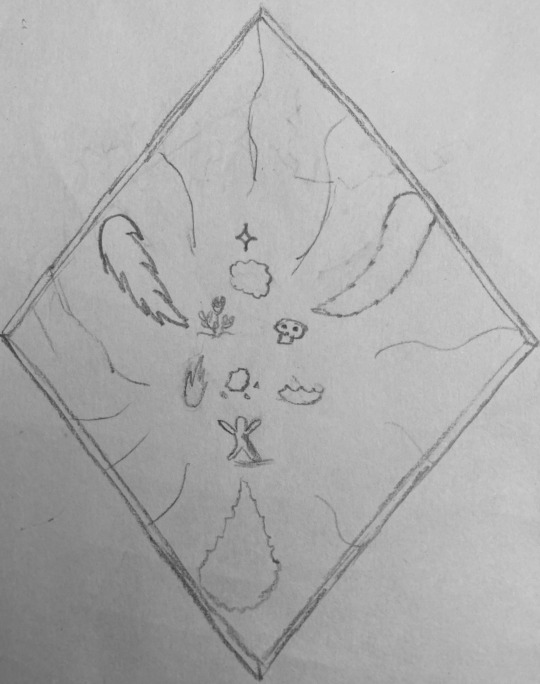
Introducing the Tumultuous Realm proper and its creative origin: the core idea was a hyper-fantasy world that blurred into sci-fi themes through its magitek and mythological stories through its surrealism. The world would be bizarre enough that overt fourth wall breaks blend into the cosmic horror/wonder of the broader setting. The Metamagic that shapes the world can change reality to make new types of magic and special abilities function, giving diegetic excuse for literally anything I want to include, with a major feature of the setting being things “just arriving” from somewhere else. It was ideal for crossovers that Author Wars was originally intended to be built around. But as the world developed more and more “local” narratives grew out of it.
I started by taking the “setting” from Dominions 3: The Awakening, which is a 4X game featuring nations inspired by a lot of real world religions. The arrival of the Vessel Departing to a simmering void where the world was explicitly artificially created by ill-understood magic fit the mechanics of how Dominions random maps worked, a lot of the core ideas grew from game mechanics I was learning as I experimented with mods. Zabbarang, the Zabbari, and the Great World Tree all originated from mods to Dominions 3 I was experimenting with. Then I was borrowing characters from friends to try and make a dream team of central Characters, and one of them was my wife (at the time girlfriend’s) Bleach OC. So the Ark of Souls was added as the creation of a Bleach/Soul Eater inspired afterlife artificially and accidentally created by humans. I added the Isle of Napay, a flipped and slightly cropped version of Anime-Japan off the west coast of the world’s only major continent. Napay was primarily based on Inuyasha’s version of Feudal Japan, but also intended to be a collage of western-interpreted and misinterpreted reads of Japanese pop culture from anime and its kin. Also super-advanced sci-fi secret cities founded by the Humans from Before, which is a popular thing in 90’s and early 2000’s anime, maybe still popular but I am only exposed to anime Isekai-Trash now. I’ll come back to that. Added an area called “Waltland” which contains edgy parody/reinventions of the Disney Princess stories as the origins of the current political/magical landscape. Though Waltland could still drift to be more generally about folklore and fairy tales. Also I added furries. Kinda not enough but I can fix that later. Got an island off the north-east coast based on the Two Kinds comic called Bastion, no points for guessing which race it features. I’ll do a real map rundown later, theoretically this post is primarily about world-rules lore and creation myth.
Speaking of which.
The Vessel Departing arrived in the empty expanse that was the far future of the surviving human’s own reality. The Knights had the wondrous Worldflame Spell and instructions on how to use it, but no real understanding of how it worked with its creators sealed safely within the Ark of Souls. They cast the Worldflame Spell onto the void.
Nine Great Flames created the world as it was, an earthen mass with a great ocean. They wove a new taxonomy of magic to guide the world and shape the creatures that would come to live on it, but they did not bestow life onto the world directly.
There were eight Base Magics to this world, to which the Humans of Before could attune themselves. From bottom to top, there was the Magic of the Promise, which corrupted to become Blood Magic, the art of curses, daemons, and devils. Then there were the Three Elemental Magics of Fire, Earth, and Water. Fire Magic caused transformation and destruction, tending to consume itself and die out. Earth Magic caused stability and consolidation, being exhausting but capable of creating great things. Water Magic caused regeneration and continuance, tending to cause cyclical changes. The Elemental Magics entered the surface world and over time generated living Elementals of their own. Then there were the Nature Magics of Life and Death. Life caused growth, generation, mutation, and relationship. Death caused decay, consumption, transformation, and enslavement. Extreme master of one Nature Magic tend to develop an affinity for the other. Avatars of Life and Death occur naturally. Then there were the High Magics of Air and Astral. Air Magic allowed manipulation and disruption of the Elemental Magics, and movement through and of things, being useful in the transition between things and places. Astral Magic breached the borders of Base Magic, fringing into Metamagic and transmuting easily into Nature, Elemental, or High Air Magic. Air Magic does not generate living forms and its spells do not degrade while active, but they cannot be stored. Astral Magic is dangerous, as it attunes naturally to Horrors and Absurds, with careless use attracting things from the void and spawning alien entities.
Once the Great Flames departed to fade in the void the Knights watched the at-first lifeless world cautiously. Then, from the smoldering sparks of the Great Flames left on the surface, the Fire Children were born. They walked as the only light on the sunless surface, wandering and playing amongst themselves. The Knights judged the Fire Children to be an acceptable threat and landed the Vessel Departing on a large island south of the mainland. It Vessel Departing was transformed into the Citadel and the Capital was founded. Still tepid the Knights were slow to awaken their support and start settling the lightless lifeless surroundings.
Then Old Mother Nilra appeared.
0 notes
Text
Demigod MC Series: Athena
So. I have to deal with the virgin goddesses… By mythos, there really shouldn't ever be children of Artemis, Hestia, or Athena (yes, Athena was a virgin goddess). PJ got past that by making it canon that Annabeth and her siblings were born from cracking open Athena's skull (yes, that's also more or less the canon explanation). They gloss over it real quick but I remember, Rick. I've always remembered and that mental image has haunted me for years...
I can't, in good conscience, ignore the history around Athena's worship (call it an academic restraint) but I REFUSE to do the skull thing. So, since I make the rules here, I'm going with magic adoption. They still get magic powers, they're just more human than demigod. Cool? Cool.
Demigod MC Series: Intro, Aphrodite, Hermes, Hades, Dionysus, Demeter, Athena
Lucifer
The human that popped out of the portal seemed to have enough sense not to attack everyone in the room for a change, but even Lucifer could tell that was more of a strategic choice than for lack of ability...
Their very existence was highly unusual… and quite worrisome. He wasn't even aware Athena could have "children" of her own, but apparently she had been taking in some particularly bright humans to raise and train like her own...
Unbeknownst to him, a surprising amount of human scholars, diplomats, and generals have her to thank for their trade… and that alone should speak to the level of intrigue at play here.
Was this an accident or Athena's attempt to plant an Olympian spy in the Devildom too…? Either way, he didn't trust them from the get go…
Look, Lucifer isn’t stupid. Athena is a goddess of Wisdom and War and war happens on more than just the battlefield…
Since they've shown up records have been going missing, official documents keep getting misplaced, and he swears that there's some kind of bug in the student council room...!
It's infuriating watching the MC suck up to Diavolo when he's almost certain that they're running their own agenda behind the scenes! And he can't prove any of it!! They cover their tracks too well!
Lucifer has one of those corkboards covered in newspapers and string in a secret wing of the Castle - 100% dedicated to just tracking the MC's activities…. The longer they're there, the more obsessed he becomes...
He swears between Simeon, Solomon, and MC he feels like a shepherd wondering why the sheep are growling… The Devildom has never been in more danger than it is right now... Send help.
Mammon
To be honest, he kind of thought that they were just going to be Satan 2.0 but that's not really true.
They're more than just a book sponge! Though they do read, like a lot. Let’s just say from one schemer to another… Game recognizes Game.
They come up with plans and ideas soooo fast, it’s insane! Honestly, there are times where he has a new money-making plot and he just brings it to the MC first to run it over.
Nine times out of ten, not only do they sniff out any problems but they have a solution for him in a matter of minutes! His scheme game has been on point since they’ve shown up!!
They’re also even better tutoring than Satan is, so he’s even managed to get a couple A’s for the first time in his life! Lucifer actually told him he was proud (which he secretly recorded and now uses as a ringtone much to his brother’s regret...)
So yeah, he likes them... buuut that doesn’t keep him from thinking they act a little weird sometimes...
Mammon: *points to a unused tower close to the RAD building* Over there is the Tower of Sorrow. We use it for storage.
MC: Ah. Interesting… *starts writing in a notebook, muttering* It may need a few minor tweaks but the location is defensible...
Mammon: *stops* Ya say somethin’?
MC: *looks back up* Nope! Say, you’ve been to the Castle a lot haven’t you? Do you know any good ways in?
Mammon: Uhm… Why do ya want to know that…? *starts looking around for Lucifer*
MC: In case of emergencies. I like being prepared. 🙂
Mammon: Look, I don’t know what Lucifer might’a told ya…
MC: I’ll pay you a thousand Grimm for it.
Mammon: Well shit, ya want those maps with or without color?
... Yeeeah, that’s pretty weird… But it’s probably fine. I mean, as long as they keep giving him money, who’s he to complain? 🤷♀️
Leviathan
Also thought that they’d be a lot more like Satan but was pleasantly surprised that they were into more than books.
What else did they like exactly? Military strategy!!
It’s been a looong time since he’s been able to talk to someone who’s actually interested in all the battles he’s fought, both in the Celestial Realm and the Devildom, and their curiosity is kind of flattering...! Not a lot of people take his strategic prowess all that seriously anymore...
Plus, they are the BEST partner to have any turn-based strategy game. Hands down. He once got stuck on a level of D-COM for weeks until the MC walked in and mopped the floor with the AI!! They have a serious head for probability and tactics.
The House once made the mistake of letting these two be on the same team during a Hell Game and they absolutely demolished the competition. Mammon didn’t even get a single shot off before half his team was lost to a rigged paint grenade… It took a whole day to clean up…
However, Levi’s also noticed some odd things about the human… He likes that they’re interested in his past but maybe they’re a little… too interested?
Levi: -and that’s how we defeated the Four Horsemen before they escaped from Purgatory.
MC: Wow, Levi that’s seriously impressive!! *furiously scribbling on a notebook*
Levi: Well t-thanks… 😅 But, uhm... are you writing that down…?
MC: Hm? Oh no, just doodling. *they lift up the notebook to show a bunch of cute little sketches on the page… and not the magic-based invisible ink all over them…*
Levi: Oh you draw too? Can you do fanart???
MC: Eh, sometimes. But say Levi, can you tell me about your naval ranks again? I’m still really curious… *gets the pen ready again with a smile*
Satan
Oh, it's been a long game of cat-and-mouse between these two… and unfortunately, it’s been pretty addicting too.
He honestly had every intention of tricking the human into making a huge mess do he could bother Lucifer, but at every turn they proved just a hair too clever for him...
He once gave them a cursed book to “lend” to Lucifer, but they saw through it the moment they touched it and lifted the spell before handing it over.
He rigged a podium to spray glitter during one of Lucifer's speeches but the MC disconnected the trigger mic before he even got on stage. It was pretty dang frustrating...
At one point he got so desperate that, just as a test, he tried to trap them in the House's Music Room. Fortunately for them, it only took a few minutes to work out an escape. They even passed by him in the hallway with a wink!
It's confounding! It's infuriating!!
...and it's so damn sexy... He should be furious but he’s just in awe!!
Add on that they know their art, literature, and multiple different crafts thanks to the tutelage of their adopted mother and that’s it. He’s finished. This boy is in love.
Truthfully though, a part of him is 90% sure that they’re also gathering state secrets… Like, they’re watching Barbs and Diavolo far too close for comfort - but he just can't bring himself to care. 🤷♀️
The MC could walk into his room one day and say, "Hey, do you want to help overthrow the monarchy with me?" and he dreads it because deep down he knows that he wouldn’t say no…
Take some notes, kids. Some bad influences get you to drink or do drugs. Others pull you into a centuries long conspiracy to destabilize and topple rival realms from within… But he has fallen for their brain hard. Devil help them all…
Asmodeus
They’re pretty clever, he’ll give them that, but uh… Are they a little off to anybody else?
Asmo is a charmer by birthright so he has a bit of nose for when someone’s just a liiittttle too nice… Not much of a nose mind you, because he can be thrown off by compliments himself, but enough to think that the MC might be a little too… “kind” for their own good...
First off, who wants to spend that much time with Levi?? They don’t even seem that interested in anime! They just keeping asking him for old war stories…
Then all the sucking up they do to Diavolo and Barbatos? Look, he gets it. Diavolo is a delicious piece of man-hunk and his butler could give him a lesson or two in sweet-talk (and he has), but they seem to be just a little too… nosy.
Of course, Asmo’s suspicions disappear pretty quickly after they start to spoil him with spa nights and beauty secrets they picked up from “casual research” into the subject.
And you know, get a little Demonus in Asmo and start massaging his back? Oh, sweetie he’ll sing like a bird!! … with gossip. Singing with gossip.
Asmo: So I’ve heard that Lucifer has been spending more time at RAD than usual… His whole club is talking about it, they think he’s meeting with some witch!
MC: Hm, is that so? *works on a knot near his shoulder blades* What do you think?
Asmo: Ooh~! Right there, MC! *purrs and lays his head on his arms* Well come on, this is Lucifer we’re talking about! I’m sure he’s just working.
Asmo: Hmm... though come to think of it, I think I heard him asking Barbatos for the spare keys to the Tower of Sorrow…
MC: Oh really? Huh. *works out the knot and gets up* I just remembered that I left some papers with Satan... I’ll be right back.
Asmo: You’re going already??
MC: *waves him off quickly* I’ll be right back, Asmo. *hurries out the door to do totally on-the-up-and-up things… surely*
Beelzebub
Honestly he doesn't like this one… But not for the reasons you'd expect.
He agrees with everyone else that they seem a little shady, but Solomon and Simeon are too so it's not like that's anything new... 🤷♀️
No, no. He dislikes them because they're the person who FINALLY figured out how to keep him from eating all the food in the kitchen!!
Turns out that the trick was to put a teleportation charm on the fridge door that would send all the food away if it’s opened after a certain time of night…
And where does it go? The Purgatory Hall fridge. And where does the Purgatory Hall food go…? The HoL fridge…
It doesn’t sound so bad until you remember that it means half of their fridge is now Solomon’s leftovers…. 🤢
After they put the same kind of spell on the pantry, it was all over… He couldn't get midnight snacks from the House anymore… Everything was contaminated by Solomon…
The MC is a nice enough person, he doesn’t have a lot of complaints about them, but he wants them to leave. Now. This is inexcusable… He’s so hungry… and he doesn’t want to die by “goulash” or whatever Solomon calls his latest culinary catastrophe… He’s still too young for death… 😓
Belphegor
In a way, he absolutely could not have asked for a better person to help him get out of that attic.
… In another way, he got one of the worst possible people to try and kill... Like. They saw through his scheme sooo fast…
How was he supposed to know that the human had training in body language and sniffing out lies???
Getting the door open was a piece of cake for them. They knew enough magic to undo the seals and just rummaged around Lucifer's stuff long enough to find the key to the door. He could not have found a more competent individual for a break out, really.
It’s just… well he didn’t expect to go from locked in a room like a prisoner to tied up in enchanted rope, still like a prisoner but now mobile. 😑
They even used his own hug ruse against him! They caught his wrists when they got close and tied him up before he could shake them off...
Admittedly, it wasn't exactly the best look for them either - what with walking Belphegor downstairs to the others like a one-man-prison-caravan but they're as silver-tongued as they are sly so they talked their way out of it beautifully…
And like hell was he going to trust them after that!! And not even Beel liked them so something had to be up...
Well, you want a detective? Look no farther than Belphie (no seriously, it’s in the canon). He can put things together pretty fast when he puts his mind to it and watching the MC for a while gave him enough proof to work off of...
He always knew that, humans were bad news and the MC just proved it to him all over again. They are bad news, bad bad news and they’re going to-!
Overthrow… Diavolo…? Is that what he is getting from them…? Huh…
Wait a second, MC. You might just have him interested… 😏
#you say athena mc is smart#i say athena mc is spy#because where better to use your smarts#in war#obey me#obey me shall we date#shall-we-date-obey-me#obey me lucifer#obey me mammon#obey me leviathan#obey me satan#obey me asmodeus#obey me beelzebub#obey me belphegor#obey me demigods
1K notes
·
View notes
Text

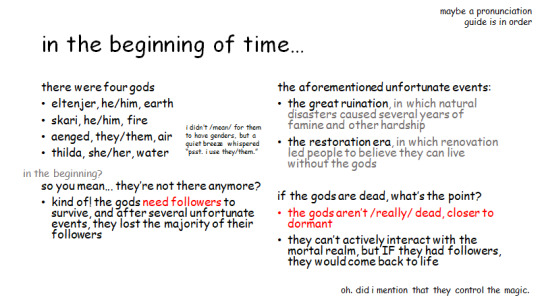
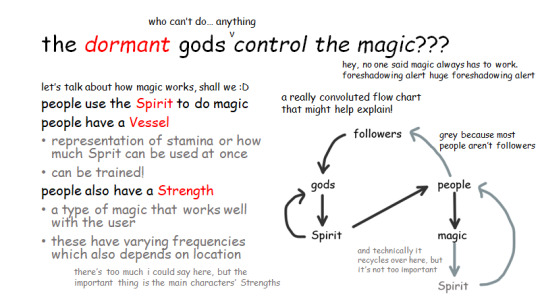

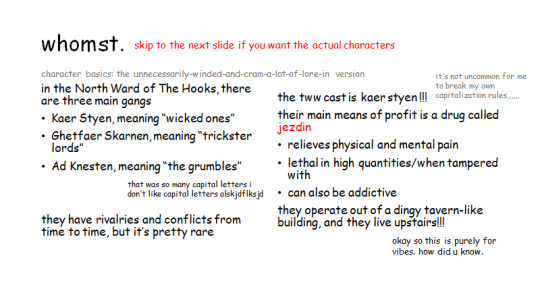
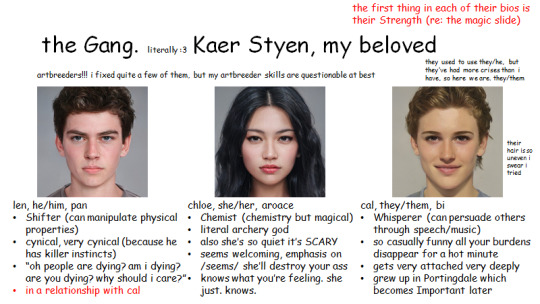
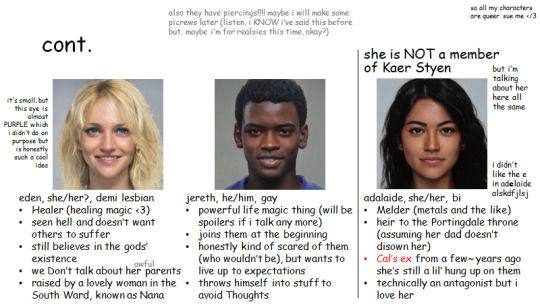


THE WICKED WITHIN—A COMIC SANS WIP REINTRO
!!!!! it's here :D the wip that started to consume me and has been continuing to do so since, now with a much better sense of what exactly is Happening
current tww taglist let me know to be +/- !! @a-completely-normal-writer @writing-is-a-martial-art @wannabeauthorzofija @magic-is-something-we-create @croctears @writeblrfantasy @opes-magnas @author-a-holmes @zoya-writes@fuyugomori @ink-fireplace-coffee
transcript is under the cut!!!
[transcript: a powerpoint presentation of black text on white background, written entirely in comic sans.
start slide one
the top left corner reads in red, "warnings (most relevant) war, death, drugs (& addiction), poison". in the center, "the wicked within", and underneath it in smaller font, "a comic sans reintro by @47crayons". the comments around the entire slide read "a family that is so found!!!", "gang rivalry :D and gang content in general", "crime found family basically", "childhood friends to STILL FRIENDS", "all queer cast :p", "eat the rich (not quite, but it’s the right sentiment aldskjfls)", "kickass women, yeah bay bee", "nuanced relationships between different groups :D", "morally grey characters!!!", "so many different governments!!!", "a (mostly alsjflksdj) stable relationship!!!"
end slide one
start slide two
in the beginning of time… there were four gods: eltenjer, he/him, earth; skari, he/him, fire; aenged, they/them, air; thilda, she/her, water. i didn’t /mean/ for them to have genders, but a quiet breeze whispered “psst. i use they/them.” in the beginning? so you mean… they’re not there anymore? kind of! the gods need followers to survive, and after several unfortunate events, they lost the majority of their followers. the aforementioned unfortunate events: the great ruination, in which natural disasters caused several years of famine and other hardship. the restoration era, in which renovation led people to believe they can live without the gods. if the gods are dead, what’s the point? the gods aren’t /really/ dead, closer to dormant. they can’t actively interact with the mortal realm, but IF they had followers, they would come back to life. oh. did i mention that they control the magic.
end slide two
start slide three
the dormant gods who can't do... anything control the magic??? hey, no one said magic always has to work. foreshadowing alert huge foreshadowing alert. let’s talk about how magic works, shall we :D people use the Spirit to do magic. people have a Vessel (representation of stamina or how much Sprit can be used at once, can be trained!). people also have a Strength (a type of magic that works well with the user, these have varying frequencies which also depends on location). there’s too much i could say here, but the important thing is the main characters’ Strengths. the right depicts an image of a flowchart showing that gods need followers and produce sprit. people need spirit to do magic.
end slide three
start slide four
okay but where are we??? where could the magic be so fucked? well, here, of course! the left side shows a line art map, split into five parts going clockwise: portingdale, worchester, the hooks, elderwood, unlabeled. the legend shows that there are mountains in portingdale, forests in elderwood, and rivers that run from portingdale to everywhere else. the place where the four labeled regions meet is called the Inner City. the text on the right reads. welcome to Kjer! there are 3 districts. but wait! there are five? sections? and one isn’t even labelled. worchester used to be a district,,, but it left after the war began. the unlabeled section is the disputed region (re: war). let’s talk more about this war. elderwood wanted easier access to water (see: the rivers in the Wetlands) elderwood & portingdale have been fighting there on and off for over half a century. the hooks has three wards: west (hella rich), south (lower income), north (somewhere in between).
end slide four
start slide five
whomst. skip to the next slide if you want the actual characters. character basics: the unnecessarily-winded-and-cram-a-lot-of-lore-in version. in the North Ward of The Hooks, there are three main gangs. Kaer Styen, meaning “wicked ones”, Ghetfaer Skarnen, meaning “trickster lords”, Ad Knesten, meaning “the grumbles”. that was so many capital letters i don’t like capital letters alskjdflksjd. they have rivalries and conflicts from time to time, but it’s pretty rare. the tww cast is kaer styen !!! their main means of profit is a drug called jezdin. relieves physical and mental pain. lethal in high. quantities/ when tampered with. can also be addictive. they operate out of a dingy tavern-like building, and they live upstairs!!! okay so this is purely for vibes. how did u know.
end slide five
start slide six
the Gang. literally :3 Kaer Styen, my beloved. the first thing in each of their bios is their Strength (re: the magic slide). artbreeders!!! i fixed quite a few of them, but my artbreeder skills are questionable at best. this slide is split into three columns. the first column shows a white person with short, brown, curly hair and a firm, but not angry, facial expression. len, he/him, pan. Shifter (can manipulate physical properties). cynical, very cynical (because he has killer instincts). “oh people are dying? am i dying? are you dying? why should i care?” in a relationship with cal. the second column shows a person who appears east asian with long, black, wavy hair and fair skin. chloe, she/her, aroace. Chemist (chemistry but magical). literal archery god. also she’s so quiet it’s SCARY. seems welcoming, emphasis on /seems/ she’ll destroy your ass. knows what you’re feeling. she just. knows. the third column shows a white person with dirty blonde hair. they are smiling. cal, they/them, bi. Whisperer (can persuade others through speech/music). so casually funny all your burdens disappear for a hot minute. gets very attached very deeply. grew up in Portingdale which becomes Important later.
end slide six
start slide seven
cont. also they have piercings!!!! maybe i will make some picrews later (listen, i KNOW i’ve said this before but. maybe i’m for realsies this time, okay?) this slide is also split into three columns. the first a smiling white female with light blonde hair. eden, she/her?, demi lesbian. Healer (healing magic <3). seen hell and doesn’t want others to suffer. still believes in the gods’ existence. we Don’t talk about her awful parents. raised by a lovely woman in the South Ward, known as Nana. this eye (left) is almost PURPLE which i didn’t do on purpose but is honestly such a cool idea. the second column shows a partially smiling black man with short curly hair. jereth, he/him, gay. powerful life magic thing (will be spoilers if i talk any more). joins them at the beginning. honestly kind of scared of them (who wouldn’t be), but wants to live up to expectations. throws himself into stuff to avoid Thoughts. the third column shows a woman with brown skin, black wavy hair, and a small smile. she is NOT a member of Kaer Styen, but i’m talking about her here all the same. adalaide, she/her, bi (i didn’t like the e in adelaide alskdfjlsj). Melder (metals and the like). heir to the Portingdale throne (assuming her dad doesn’t disown her). Cal’s ex from a few~ years ago she’s still a lil’ hung up on them. technically an antagonist but i love her. so all my characters are queer sue me </3
end slide seven
start slide eight
some semblance of plot? coming right up!! the four (jereth isn’t there yet!) are attacked in the Inner City. turns out it’s portingdale soldiers. and then they discover that portingdale has been poisoning the southern rivers (affects worchester and the south ward) because worchester doesn’t really contribute to Kjer as a whole. word gets out, and elderwood, naturally, is even angrier at portingdale (remember, they've been at war). so, they try to stop portingdale from being power hungry enough to poison the entirety of a country while learning about why worchester is so isolated while ALSO trying not to get killed by everyone who hates them.
end slide eight
start slide nine
memes :> the first is the meme of spongebob reading a sheet of paper and burning it. the paper reads, "going into worchester by yourself is going to get you KILLED", and spongebob is labelled "chloe". the second is the levels of brain template labelled "jereth". from the weakest to most powerful: "trying to figure out his magic", "doing it by accident", "saving everyone's lives". the third is the sleeping person and brain meme. brain: "you're going to portingdale". cal: yeah, i know. brain: you'll see adalaide. cal's eyes are wide open in fear. the fourth says "corporate needs you to find the difference between this image and this image". the first image says, "family", and the second one says, "len, chloe, cal, jereth." eden says, "they're the same picture". the fifth is the spiderman copycat meme where jereth is copying len.
end slide nine
/end transcript]
80 notes
·
View notes
Text
Gnostic Boardwalk

Canonical stature is a fragile and contingent thing, which is why powerful institutions seek to shore up the various canons of art with rankings and plaudits. We’ll play along by asserting that one of our favorite “B” movies was originally screened by Henri Langlois at the Cinematheque française with Georges Franju in attendance. Night Tide (1961) was an unlikely contender for this particular honor—shot guerrilla style on an estimated $35,000 budget, and intended, by its distributors at least, for a wider, less demanding audience seeking mostly air-conditioned escapism.
With its hinky cast—nonfictional witch, Marjorie Cameron; erstwhile muse to surrealist filmmaker Jean Cocteau, the undersung Babette who usually appears en travesti; and lecherous, booze-addled, fresh-faced Hollywood castoff Dennis Hopper—Night Tide invades the drive-in. A tarot reading at the film’s heart gives Marjorie Eaton her time to shine, traipsing into nickel-and-dime divination from her former life as a painter of Navajo religious ceremonies. Linda Lawson might have issued from an etching by Odilon Redon, with her raven locks and spiritual eyes, our resident sideshow mermaid. Not surprisingly and despite such gentle segues, the film itself traveled a rocky road from festivals to paying venues.
Night Tide had spent three years languishing in the can when distributor Roger Corman smuggled the unlikely masterwork into public consciousness, another of his now legendary mitzvahs to art. And the sleazy-sounding double bills that resulted also unleashed an aberrant wonder: the movie’s compact leading man, a force previously held captive by the studio system—looking, here, like some homunculus refugee from the Fifties USA. Dennis Hopper, in his first starring role, would later recall that it represented his first “aesthetic impact” on film since his earlier appearances in more mainstream productions such as Rebel Without a Cause and Giant had denied him meaningful outlets for collaboration.

It’s the presence of its featured players—certainly not their star power—that lends the film its haunting and enduring legacy, and elevates the term “cult classic” to its rightful place in the pantheon of cinema. But we argue that Night Tide remains outside these exclusive parameters—upholding an elsewhere-ness that defies commercial, if not strictly canonical, logic. Curtis Harrington’s first feature film escapes taxonomy, typology or genre—gets away—fueling itself on acts of solidarity instead. If Hopper contributes his dreamy aura, then Corman rescues the seemingly doomed project by re-negotiating the terms of a defaulted loan to the film lab company that was preventing the film’s initial release. His generous risk birthed a movie monument that would add Harrington’s name to a growing collection of talent midwifed by the visionary schlockmeister responsible for nursing the auteurs of post-war American cinema. And here we enter a production history as gossamery as Night Tide itself.
Unlike his counterparts entrenched within the studio system, Harrington was an artist – i.e. a Hollywood anachronism, with aristocratic graces and a viewfinder trained on the unseen. We see Harrington as Georges Méliès reborn with a queer eye, casting precisely the same showman’s metaphysics that spawned cinema onto nature. By the time moving pictures were invented, artists were moving away from a bloodless representational ethos and excavating more primordial sources for inspiration. The early stirrings of what surrealist impresario André Breton would later proclaim: “Beauty will be CONVULSIVE or it will not be at all.”
Harrington owned a pair of Judy Garland’s emerald slippers, and according to horror queen/cult icon Barbara Steele, also amassed an eclectic array of human specimens: “Marlene Dietrich, Gore Vidal, Russian alchemists, holistic healers from Normandy, witches from Wales, mimes from Paris, directors from everywhere, writers from everywhere and beautiful men from everywhere.” On a hastily constructed Malibu boardwalk, Hopper would be in his milieu among the eccentric denizens of California’s artistic underground—most notably, Harrington himself, a feral Victorian mountebank of a director who slept among mummified bats, practiced Satanic rites, and hosted elaborate and squalid dinner parties. One could almost picture the mostly television director in his twilight years as Roman Castavet of Rosemary’s Baby; a spellbinding raconteur with a carny’s flair for embellishment and enticement. Enthralled by the dark gnosticism of Edgar Allan Poe that had started when the aspiring 16-year-old auteur mounted a nine-minute long production of The Fall of the House of Usher (1942), Harrington would embark on a checkered film career that combined his occult passions with the quotidian demands of securing steady employment. Night Tide, a humble matinee feature whose esoteric underpinnings would spawn subsequent generations of admirers, united the competing forces of art and commerce that Harrington would struggle with throughout his career. Like Méliès, Harrington pointed his kinetic device towards the more preternatural aspects of early motion pictures to seek out the ‘divine spark’ that Gnostics attribute to transcendence, and the necessary element to achieve that immortal leap into the unknown. What hidden meanings and unspeakable acts Poe had seized upon in his writing were brought infernally to life with a mechanical sleight-of-hand. It was finally time for crepuscular light, beamed through silver salts to illuminate otherworldly and other-thinking subjects.

Curtis Harrington
By the time Harrington had embarked on his feature film debut, a more muscular celluloid mythology based on America’s proven exceptionalism was in full force, taking on a brutalist monotone cast in keeping with the steely-eyed, square-jawed men at the helm of a nascent super-power, consigning its more feminine preoccupations to the dusty vaults where celluloid is devoured by its own nitrate. Harrington would resurrect the convulsive aspects of his chosen vocation and embed them deep within the monochrome canvas he’d been allotted for his first venture into feature filmmaking, and combine them with the more rational aspects of so-called realism. In the romantic re-telling of a familiar myth, Harrington was remaining true to gnostic roots and the distinctly poetic language used to express its cosmological features.
In Night Tide, Harrington would map the metaphysical terrain that held up Usher’s cursed edifice as a blueprint for his own work that similarly explored the intertwined duality of the natural and the supernatural. The visible cracks that reveal a fatal structural weakness and a loss of sanity in both Roderick Usher and his doomed estate are evident in Night Tide’s conflicted heroine compelled to choose between her own foretold death underwater, or a worse fate for those who fall in love with her earthly human form.
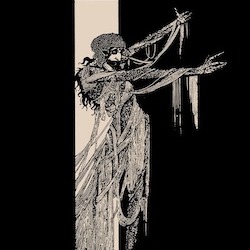
A young sailor (Dennis Hopper) strolling the boardwalks of Malibu while on shore leave offers the viewer an opening glimpse into the film’s metaphysical wormhole, and a not so subtle hint of the director’s queer eye, stalking his virginal prey in the viewfinder. A beachfront entertainment venue is, after all, where one would casually encounter soothsayers and murderers, sea witches and perverts, as the guileless Johnny does, seemingly oblivious to the surrealist elements of his surroundings as he makes his way on land.
Harrington’s carnival-themed underworld is both imaginatively and convincingly presented as a quaint slice of post-war America, effortlessly dovetailing with his intended drive-in audience’s expectations of grind house with a dash of glamor—not to mention his own avant-garde leanings, which remain firmly intact despite Night Tide’s outwardly conventional construction and narrative.
Harrington is able to present this juxtaposition of kitsch Americana and the queer arcana of his occult fascinations. Indeed, Night Tide’s lamb-to-the-slaughter protagonist could have wandered off the set of Fireworks, Kenneth Anger’s 1947 homoerotic short film about a 17-year-old’s sadomasochistic fantasies involving gang rape by leathernecks.
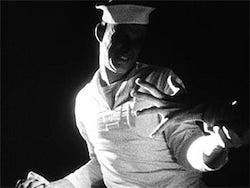
Anger would later sum up his earliest existing film as “A dissatisfied dreamer awakes, goes out in the night seeking a ‘light’ and is drawn through the needle’s eye. A dream of a dream, he returns to bed less empty than before.” Harrington (a frequent collaborator of Anger in his youth) seems to have re-worked Fireworks, or at least its underlying queer aesthetic into a commercially viable feature film that explores his own life long occult fascinations.
Both Anger and his former protégé would view the invocation of evil as a necessary step towards the attainment of a higher level of consciousness. Harrington coaxed a more familiar story from the myths and archetypes that informed his unworldly views for a wider audience; a move that would be later interpreted by sundry cohorts as selling out. Still, Night Tide shares a thematic kinship with Anger’s more obtusely artistic output as acknowledged by the surviving occultist, who confirmed this unholy covenant at Harrington’s funeral by kissing his dead friend on the lips as he laid in his open coffin.
The hokey innocence of Dennis Hopper as Johnny Drake in his tight, white sailor suit casts a homoerotic hue on the impulses that compel him to navigate a treacherous dreamscape to satisfy a carnal longing, just as Anger’s dissatisfied dreamer obeys the implicit commands of an unspeakable other to seek out forbidden pleasures.
As he makes his way on land, the solitary, adventure-seeking Johnny will be lured into a waiting photo booth, his features slightly menacing behind its flimsy curtain, and brightly smiling a second later as the flash illuminates them. Johnny has entered a realm where intersecting worlds collide, delineating light from shadow, consciousness from unconsciousness. The young sailor’s maiden voyage into the uncharted waters of his subconscious is made evident in the contrasting interplay captured by the camera, where predator and prey overlap in darkness. Here, too, we get a prescient preview of the deranged psychopath Hopper would subsequently personify in later roles, most significantly as the oxygen deprived Frank of Blue Velvet—a man who seems to be drowning out of water. But here, Hopper convincingly (and touchingly) portrays a wide-eyed naïf, still unsteady on his sea legs as he negotiates dry land.
As a variation of Anger’s lucid dreamer in Fireworks (and later Jeffrey of Blue Velvet) Johnny will have abandoned himself quite literally (as his departing shadow on a carnival pavilion suggests, before its host blithely follows) to his own suppressed sexual urges; a force that eventually compels him towards denouement.
Moments later, inside the Blue Grotto where a flute-led jazz combo is in progress, Johnny spots a beautiful young woman (Linda Lawson) seated directly across from him. Her restrained and almost involuntary physical response to the music mimic his own, offering the first indication of a gender ‘other’ residing in Johnny; an entombed apparition cleaved from the sub-conscious and projected into his line of vision. Roderick and Madeline Usher loom large in Harrington’s screenplay and Usher’s trans themes lurk invisibly in the subtext. Harrington is arguably heir apparent to Poe’s vacated throne, pursuing similar clue-laden paths and exploring the dual nature of human and the primordial creature just beneath the surface poised to devour its host.
The near literal strains of seductive Pan pipes buoyed by the ‘voodoo’ percussion sets the stage for Harrington’s reworking of the ancient legend of sea-based seductresses and the sailors they lure to their graves.

Marjorie Cameron (or ‘Cameron’ as she is referred to in the opening credits) makes a startling entrance into The Blue Grotto as an elder of a lost tribe of mermaids seeking the return of an errant ‘mermaid’ to her rightful place in the sea. Cameron, a controversial fixture in L.A.’s bohemian circles and one-time Scarlet Women in the mold of Aleister Crowley’s profane muses, would later appear in Anger’s The Inauguration of the Pleasure Dome, and as the subject of Harrington’s short documentary The Wormwood Star (1956).
The inclusion of a bonafide witch, along with a host of less apparent occult/avant-garde figures, is further evidence of Night Tide’s true aspirations and its filmmaker’s subversive intent to sneak an art-house film into the drive-in, and introduce its audiences to the heretical doctrine that had spawned a new generation of occult visionaries influenced by Edgar Allan Poe. Decades later, David Lynch would carry that proverbial torch, further illuminating the writhing, creature-infested realm underlying innocence.
Johnny approaches the young woman who rebuffs his attempts at conversation, seemingly entranced by the music, but allows him to sit, anyway. Soon they are startled by the presence of a striking middle-aged woman (‘Cameron’) who speaks to Johnny’s companion Mora in a strange tongue. Mora insists that she has never met the woman before, nor understands her, but makes a fearful dash from the club as Johnny follows her, eventually gaining her trust and an invitation the following day for breakfast.

Mora lives in a garret atop the carousal pavilion at the boardwalk carnival where she works in one of the side show attractions as a “mermaid.” Arriving early for their arranged breakfast, her eager suitor strikes up a conversation with the man who runs the Merry-Go-Round with his granddaughter, Ellen (Luanna Anders). Their trepidation at the prospecting Johnny becoming intimately acquainted with their beautiful tenant is apparent to all except Johnny himself, who is even more oblivious to Ellen’s wholesome and less striking charms. Even her name evokes the flat earth, soul-crushing sensibilities of home and hearth. Ellen Sands is earthbound Virgo eclipsed by an ascendent Pisces. (Anders would have to subordinate her own sex appeal to play this mostly thankless “good girl” role. She would be unrecognizable a few years later as a more brazenly erotic presence in Easy Rider, helping to define the Vietnam war counterculture era.)
As Johnny ascends the narrow staircase leading to Mora’s sunlit, nautical-themed apartment, he almost collides with a punter making a visibly embarrassed retreat from the upper floor of the carousel pavilion. Is Johnny unknowingly entering into a realm of vice and could Mora herself be a source of corruption? Her virtue is further called into question when she not so subtly asks Johnny if he has ever eaten sea urchin, comparing it to “pomegranate” lest her guest fails to register the innuendo that is as glaring as the raw kipper on his breakfast plate. Johnny admits that he has never eaten the slippery delicacy but “would like to try.” Moments later, Mora’s hand in close-up is stroking the quivering neck of a seagull she has lured over with a freshly caught fish, sealing their carnal bond.
Their subsequent courtship will be marred by an ongoing police investigation into the mysterious deaths of Mora’s former boyfriends, and her insistence that she is being pursued by a sea witch, seeking the errant mermaid’s return to her own dying tribe. Her mysterious stalker will make another unwelcome entrance after her first appearance in the Blue Grotto—this time at an outdoor shindig where the free-spirited young woman reluctantly obliges the gathered locals who urge her to dance. The sight of ‘Cameron’ observing her in the distance causes the frenzied, seemingly spellbound dancer to collapse, setting off a chain of events that will force Johnny to further question her motives and his own sanity.
Mora’s near death encounter through dance is an homage of sorts to another early Harrington collaborator and occult practitioner. Experimental filmmaker Maya Deren had authored several essays on the ecstatic religious elements of dance and possession, and later went on to document her experiences in Haiti taking part in ‘Voudon’ rituals that would be the basis of a book and a posthumously released documentary both titled Divine Horsemen: The Living Gods of Haiti. Note the Caribbean drummers whose ‘unnatural’ presence, in stark contrast to the more typical Malibu beach party celebrants, hint at the influence of black magic impelling the convulsive, near heart-stopping movements that eventually overtake her ‘exotic’ interpretive dance.

The opening sequence of Divine Horsemen includes a woodblock mermaid figure superimposed over a ‘Voudon’ dancer. The significance of this particular motif was likely known to Harrington, a devotee of this early pioneer of experimental American cinema. Deren herself appeared as a mermaid-like figure washed ashore in At Land (1947) who pursues a series of fragmented ‘selves’ across a wild, desolate coastline. Lawson with her untamed black hair and bare feet could be a body double of Deren’s elemental entity traversing unfamiliar physical terrain to find a way back to herself.
Mora’s insistence that she is being shadowed by a malevolent force directly connected to her mysterious birth on a Greek Island and curious upbringing as a sideshow attraction compel Johnny to investigate her paranoid claims, hoping to allay her fears with a logical explanation for them. The sea witch (or now figment of his imagination) will guide the sleuthing sailor into a desolate, mostly Mexican neighborhood where her departing figure will strand him—right at the doorstep of the jovial former sea captain who employs Mora in his tent show as a captive, “living, breathing mermaid.”
The British officer turned carnie barker is in a snoring stupor when Johnny first encounters him, snapping unconsciously into action to give a rote spiel on the wonders that await inside his tent. Muir balances Mudock’s feigned buffoonery with a slightly sinister edge. When Johnny arrives at his doorstep to find out more about the ongoing police investigation into her previous boyfriend’s deaths, the captain’s effusive hospitality takes on a decidedly darker tone when he guides his visitor to his liquor/curio cabinet where a severed hand in formaldehyde, “a little Arabian souvenir,” is cunningly placed where Johnny’s will see it. The spooky appendage serves as a reminder to Mora’s latest suitor of the punishments in store for a thief.
Captain Murdock’s Venice beach hacienda is yet another one of Night Tide’s deviant jolts: a fully fleshed out character in itself that speaks of its well-travelled tenant’s exotic and forbidden appetites. The dark, symbol-inscribed temple Johnny has entered at 777 Baabek Lane could be a brick-and-mortar portal into this mythic, mermaid-populated dimension that Johnny’s booze-soaked host thunderously defends as real.
Before falling into another involuntary slumber, Murdock will try to convince Johnny that while he and Mora merely stage a sideshow illusion, “Things happen in this world”—or, more to the point, Mora’s belief that she is a sea creature is grounded in fact.
Murdock’s business card that Johnny handily has in his pocket while tailing his dramatically kohl-eyed mark is oddly inscribed with an address more likely to be an ancient Phoenician temple of human sacrifice (Baalbek) than a Venice Beach bungalow. A lingering camera close-up offers another tantalizing, occult-themed puzzle piece—or perhaps a deliberate Kabbalah inspired MacGuffin. The significance of numbers as the underlying components for uniting the nebulous and intangible contents of the mind with the more inert, gravity bound matter, existing outside it, as the ancient Hebrews believed, wouldn’t have been lost on Night Tide’s mystically-minded helmer. Mora’s explicitly expressed disdain for Johnny’s view of the world as a rationally ordered, measurable entity that could be mathematically explained, reinforces Harrington’s world view, his love of Poe, and those French Symbolist artists who interpreted him.
In Odilon Redon’s Germination (1879), a wan, baleful, free-floating arabesque of heads of indeterminate gender suggests either a linear, ascending involution, or a terrifying descent from an unlit celestial void into a bottomless pit of an all-too-human, devolving identity. Redon’s disembodied heads gradually take on more human characteristics, culminating into a black-haloed portrait in profile. The cosmos of Redon’s etching is governed by an unexplained, inexplicable moral sentience, which absorbs the power of conventional light. Thus black is responsible for building its essential form, while glimmers of white, hovering above and below, prove ever elusive; registering as somehow elsewhere, beyond the otherwise tenebrous unity of the picture plane.
Night Tide has its own unsettling dimensions, of course, this black-and-white boardwalk where astral, egalitarian bums want to tip-toe; and, somehow, practically all of them do. Not a movie but an ever-becoming place, crammed into low-budget cosmogenesis unto eternity. We won’t discuss the ending here, since it hasn’t happened yet.

by The Lumière Sisters
18 notes
·
View notes
Text
I thought this needed to be its own post, since it’s a huge meta and I really loved writing it.
The following is my attempt to analyze the symbolism and staging of @tenyai ‘s impeccable storyboards to Douxie and Merlin’s farewell, in the final episode of Wizards: Tales of Arcadia.
Teny, your boards and the thoughtfulness, heart, and passion you put into them have legit inspired me to take up boarding as a truly narrative, imaginative, and character-driven art. Thank you for these and for all the love. Your skill and craftsmanship and sincerity of emotion come shining through in these arts, and it warms my heart and fills me with absolute joy. I’ve been in awe of your handle of cinematographic symbolism ever since you teased so much meaning out of the final scene in Killahead Part 2, and I’ve changed my entire view on how to analyze scenes and characters on screen because of it. I cannot wait to see your analysis of this scene. It’s rich and powerful in ways I cannot even express.
People, please go check out her boards on her blog and at her professional portfolio on the website in her bio!!
______
Waking up in Merlin’s Study
First up, parallelisms… Merlin’s study is the symbol of everything Douxie is aspiring to in his life. It’s the heart of Merlin’s knowledge, his position as a master and a wizard. It’s full of things Douxie is off-limits to (like the safe or the time map), as we saw in the second episode. He’s always been a student and an inferior in this room; that’s why he considers it an ironic Hell. But unlike in “Dragon’s Den,” when he wakes up in this room on the floor, scared and confused––here instead, he wakes up on the table, surrounded by Merlin’s books, Merlin’s knowledge. And he’s much more comfortable and relaxed. Symbolically, he’s not scrubbing the floor anymore as an inferior.

I almost want to say that Merlin’s tables represent the places where Merlin crafts and makes things––like in “History in the Making” when he is shown making the amulet over one of the tables in his study. But in this case, the person Merlin had a hand in crafting was Douxie. And being a father to Douxie, by saving him from the streets, is Merlin’s greatest accomplishment. He may have saved Douxie, but Douxie took on a life of his own and surpassed Merlin’s wisdom, in a way much like the amulet took on a foresight far more wise than Merlin could have ever predicted (choosing a human to be the Trollhunter, despite Merlin’s belief that a human wasn’t enough).

Walking to the Light
After Douxie wakes up, we get the walk towards the Light, with Merlin starting out in the Light and by the end of this scene, falling into Shadow. Symbolizing Douxie’s growth and perception of Merlin, and symbolizing Merlin’s position as Master Wizard of this realm and his willful relinquishing of that role to Douxie. At first, Douxie wakes up, thinking about his past in this room and all the service he did for his master––who in this shot appears as a hazy halo-ed vision speaking down at him from the unattainable glow: “Hello there, boy,” said with the kind of judgmental snide Douxie’s used to from Merlin.

Then they start walking and then we hit the window at the far end of the room, a kind of apex in the parabolic staging of Douxie and Merlin’s movement through the scene––with the arc going from the back of the room and the table, to the window, and swinging again to the back, this time from the right side of the room. Merlin’s dialogue when we hit the window is important. He’s first talking about how he’s dead and vaporized into soot, etc, and then he opens the time map and asks, “The question really is, Why are you here?” A charged, thematically rich question placed right when we see the mingle of blue and green light from the time map’s lenses––the mingling of these two’s lives through the ages, the summation of all Douxie’s insecurities and all Merlin’s expectations, all Douxie’s greatest mistakes and his greatest triumphs.

Why Are You Here?
Why is he here? At this point, Douxie’s finally let go, he’s accepted Merlin’s death, accepted the title of successor, accepted his gifts and powers and heroism. And he’s accepted that death is part of the job of Master Wizard if it means saving those he’s sworn to protect. So why is he here? Because he’s done everything and more that a true Master Wizard is supposed to do. He’s equalled Merlin, nay––surpassed him in heroism, wisdom, and responsibility. The mingling of the time map’s lights symbolizes that Douxie has achieved everything Merlin represented to him, and more.
And then Douxie touches the Light, looking out into the glow of the hereafter, saying nothing (I love that and makes me crave for his thoughts).

There’s something so fundamentally and chillingly introspective and metaphysical here in this shot for me. It comes on the heels of not only “Why are you here” but also “I am most certainly dead. You saw me vaporize into soot.” Cuz that’s what happens when we all go, isn’t it? You might be the wisest person on this earth, mastered all there is to know about life, become the greatest wizard, lived a thousand years and more, and still in the end, you will die, and to the dust you will return. Maybe Douxie’s thinking, Am I here because I’m dead too? Because my body is gone, because somewhere out there beyond the stained glass is the explanation of the mystery of what happens when we die? Because even if you master life, there is no mastery over death, because none of us will ever feel what it truly is to be on the other side until we get there?
Separate and Equal
Symbolically, with the lighting, it also means Douxie’s touched Wisdom/Maturity in a way. If the hazy glow of Merlin at the start was from this Light, from this Unattainable Essence––then by the time of this staging’s apex, Douxie has achieved what Merlin has. He’s touched the thing that he has sought for so long. He too can be framed by the Light of the person he wanted to be. So now, we see Douxie talking back to Merlin, and not being silent anymore.

Merlin and Douxie are on the same plane now––as equals. We get the vitally important shot of them side by side, Douxie laughing off Merlin’s disapproval, both of them framed by the Light, both of them standing on their own, balanced by the pillars and the light, each of them solid and independent, separate and equal.
Douxie’s Need for Validation
And then we get to the other side of the parabola, the shift in Merlin’s dialogue from disapproval to one of admiration and pride. “I can see you no longer need my validation.”

This line kills me, because you can see in Douxie’s face that yes, he does. Oh how he desperately wants it. But he’s worked so hard to NOT need it, so that he can grow and flourish. And Douxie falls back into that quiet again, waiting on Merlin’s every word, because his rebellious veneer is stripped right now. Merlin’s hitting on the core of his needs, the source of his insecurity. In the film version, he’s even holding his hands together in front of him, and if that body language means anything to me, it’s Douxie feeling small and childlike again, needing and wanting something from his Dad but not having the courage to tell him.

Staging-wise, Douxie’s still very much following Merlin. He’s behind him, chasing after him, looking up to him. The “ancient Draconic” stand-off was the first and most important show of Douxie’s growth, born from Douxie’s own gumption and sass, when Merlin for the first time in this scene walked up to *Douxie* instead of the other way around, even if it was to judge him:

But like any good hero’s journey, after one win, our hero gets a setback, a reminder of his failures, before he wins again. And this time, it’s Douxie feeling like this latest monologue from Merlin is again some kind of judgement, some kind of backhanded lecture. Would his show of strength and independence fall on deaf ears?
“Remember when I told you that magic is mastery over life?” Merlin says, holding up an alchemy bottle and then a book––tools of the trade, spellcraft and tricks. All the things Merlin taught him. In a huge way, Merlin wasn’t there for the real lessons Douxie learned to become truly wise. Douxie became strong and selfless and kind because he had to, because those were the ways he knew in his heart would take him on the path to reaching that wisdom of life Merlin was talking about. I wonder if there’s something to the fact that once Merlin starts saying, “Nine hundred years you’ve guarded this realm…” he puts the book away––putting away his own knowledge and symbolically recognizing that Douxie’s wisdom has taken him far past Merlin’s own teachings, and that in the 900 years that went by, Douxie has guarded this realm with a mastery of life all his own.

In the final version, the moment Merlin says, “You’ve disrupted time, freed ancient beasts,” that’s when Douxie drops his hands, stops walking, and looks down––a brushstroke reminder of his guilt on doing these things, things that Merlin disapproved of, but things Merlin is now seeing as good and right things to do.

And then we get to the shot of the amulet blueprints, and the wonderful crowning statement of Douxie’s morality: “You’ve… fought to save one life at the risk of countless others.” Meaning Jim, meaning the very person who inspired Douxie to take his selflessness that one step further and set aside his own life so that he could save everyone. Because every life is precious. I find it fascinating that on this line in the boards, Douxie silently fist-slams the table, disappointment all over his face. While Merlin, now in Shadow, has a look of wistful regret.

This shot is so pack full of meaning, and I keep adding to this interpretation...
Douxie for so long has been stripped down for everything he’s done, been criticized by Merlin for being different from him. In some ways, he thinks this latest monologue is more of the same, more ways in which he’s disappointed his father. And clearly, despite his growth, it still hurts him.
And it hurts him that while Merlin is talking about saving Jim’s life, Douxie never really was able to save him. Douxie died while Jim was still corrupted. He died only seeing Jim lose himself to the Green Knight. He never saw Claire’s heroism in bringing Jim back. Personally, Douxie failed.
But even more than that, it hurts him that for all his love for Merlin, he could not save him. He might give his life to save the world, but he cannot bring Merlin back from the grave. Every life is precious and he would risk countless to save just one. But he couldn’t save the one that meant the most to him.
Merlin recognizing he’s wronged Douxie
In the end, Merlin here isn’t talking Douxie down, even as he’s pointing out their differences. He’s in awe at this idealism Douxie possesses. He’s not criticizing him, he’s not being wry or ironic. Merlin looks up at the portrait, knowing that it wasn’t him who gave Douxie this outlook on life. It wasn’t his harsh treatment that gave Douxie his beautiful soul. Douxie had it all along, and Merlin was too dense to see it and nourish it.

So what Merlin says next hits even deeper––

“And yet, despite such relentless hardships…” Merlin’s looking up at the portrait. He’s looking at himself. He’s looking at everything he’s done to Douxie that’s burdened his son with that guilt, that insecurity, that fear, that emotional abandonment. He’s acknowledging here his part in the trauma of Douxie’s life, and his regret is that all this time, it was Douxie who was the better man than he was.

And then we get the symbolic shot––“Despite such relentless hardships, you managed to protect those dearest to you”––with Merlin in Shadow and Douxie lit from behind with the Light. A reversal of the opening shot of this scene, when it was Merlin in the Light and Douxie, unsettled, in the Shadow. This is finally Merlin laying down his ego, seeing in Douxie the strength and force of love and protectiveness he never had. The very thing Merlin didn’t do, when he didn’t protect Douxie all those years, when he let his son down, when he left him and ignored him and took him for granted. When he didn’t give the person dearest to him the love he deserved.

Resolution
And finally, it’s Merlin walking *up* to Douxie, Merlin falling in Douxie’s shadow, and Douxie being once and finally again on an equal plane with his master and peer. “My Hisirdoux, what a life you’ve lived. What a wizard you’ve become.” This is the climax of Douxie’s parabolic hero’s journey in this room. Merlin has at long last given to him what he desperately needed to hear––pure, unadulterated pride in his father’s eyes, and an honest and sincere expression of love, kindness, and emotion.


It’s too much for Douxie’s desperate heart, and he collapses into his father’s arms, releasing 900 years of pent-up emotions and need.


(Is that symbolically why Merlin’s always in armor and Douxie never had any––cuz he’s fragile and bare in the face of Merlin’s cold, callous exterior?)
After that hug (waaaah TEARS, every. freaking. time), we once again are treated to the Light symbolism. First again to show how equal these two men are––Merlin importantly a step down from his son, with the light behind Douxie. And then to show the time map, glimmering with a calm, peaceful, happy equality.


Life and Death
And now we’re in scene denouement, as Merlin and Douxie walk to the end of the parabola (past the first table and eventually out the door). Fascinatingly, in the boards, Douxie glances around the room and then his eyes I believe land on the table he woke up in earlier, before the scene cuts and we get a shot of that same table, panning up to reveal Merlin and Douxie facing the doorway to the hereafter.


And in my brain, it’s like we’ve come full circle in Douxie’s life arc. If waking on your back is birth, snarking about your tough childhood, and now after all you’ve gone through, you look back on that time at the end of your days, ready to face what comes after death…. (well, that’s what it means to me anyway).
Douxie’s fully prepared to leave the mortal world. That’s how far he’s come in his maturity. He closes his eyes, accepting the unknown and resting in the confidence of who he is.

The Hero’s Journey
But like any good hero’s journey, the end isn’t to leave the ordinary world with the boon of your new knowledge and wisdom. It is to return to your home and share that knowledge with others, to use what you have gained and become a teacher and protector for your family and community.

Merlin gives him one last lesson, one last parting gift to tell him, Hey, you have more power than you even imagine you possess. Your rebellious spirit made you who you are today, and it’s what will keep you alive and fighting because it’s your gift and how you protect the world. Your way.

Merlin’s parting sign of the horns is the cherry on top of this whole thing, a perfectly subtle way of Merlin acknowledging who Douxie is, accepting it, and celebrating it. Saying goodbye to his son in a language meant for him. Douxie’s tears at the end (wish they got into the final oof!) speaks volumes to his beautifully mingled emotions––amusement at Merlin’s gesture and a poignant love that he did it for him. I tear up just thinking about the look on Douxie’s face and what it all means in his heart.

Anyway, that’s a wrap, folks. I love Douxie with my entire soul. Thank you for sharing these boards, Teny, and for putting your heart and tears into this masterwork of a scene. (I listened to “Moving On” to write this for the Mood and guhh, it’s a tear-jerker gosh.) This fandom is incredibly lucky to be the recipients of your favorite sequence in your career to date. It’s been an absolute pleasure to see your work and feel the heart you poured into them.
#tales of arcadia#toa wizards#douxie#hisirdoux casperan#toa meta#toa wizards meta#tales of arcadia wizards#douxie meta#merlin#douxie x merlin#*mine#*mymeta#tenyai#toa wizards storyboards#long post
185 notes
·
View notes